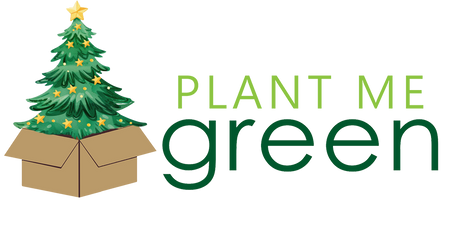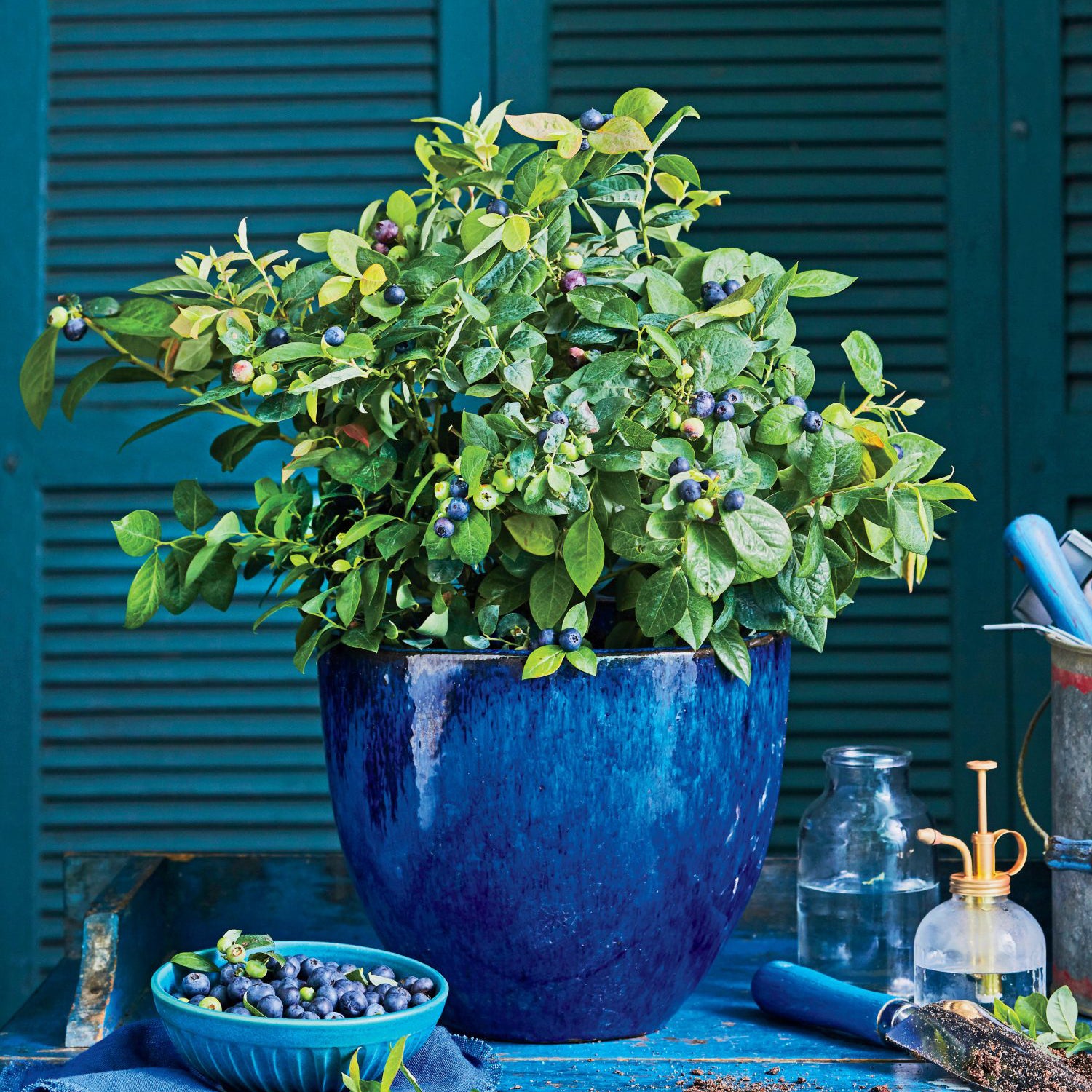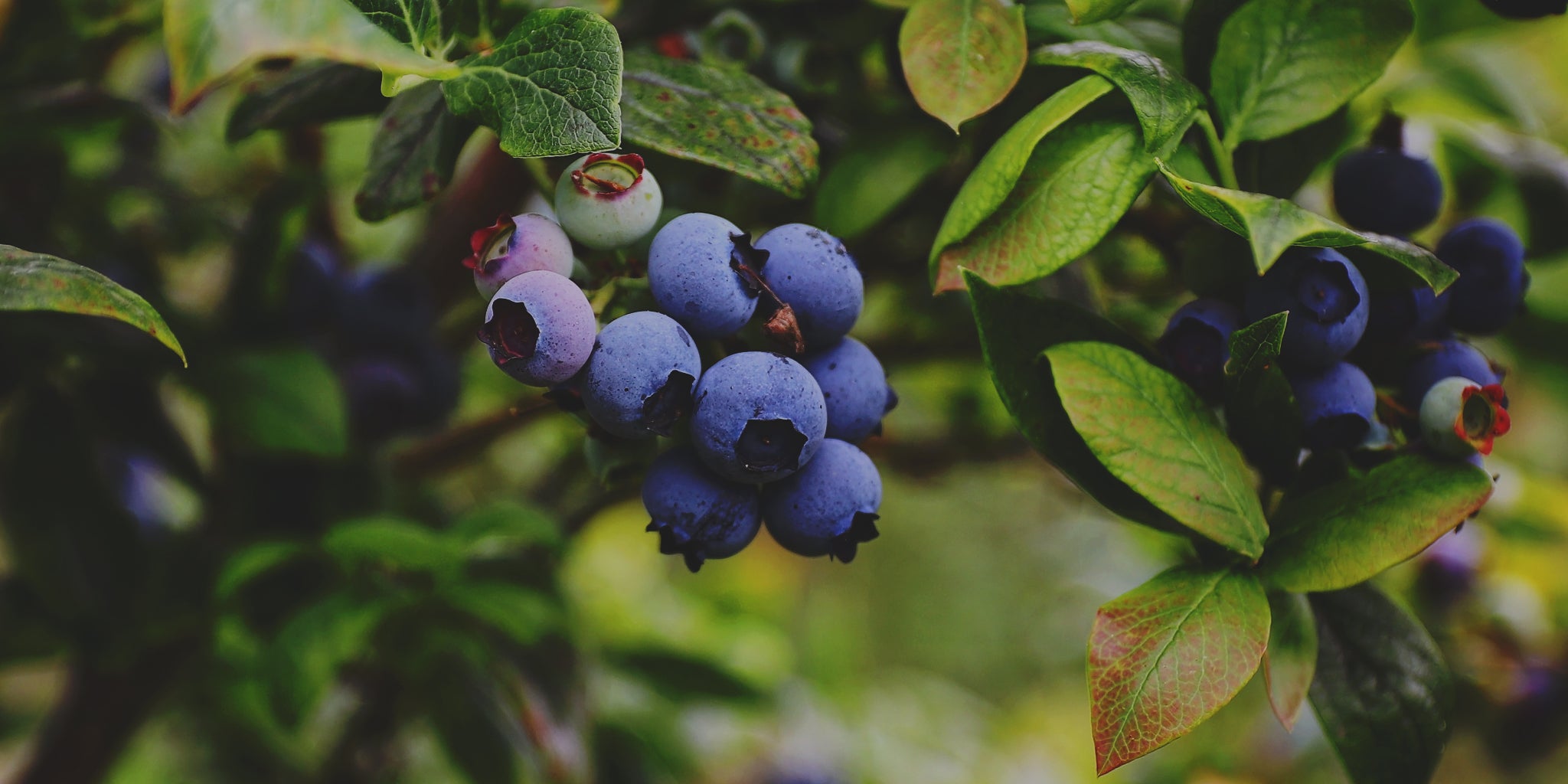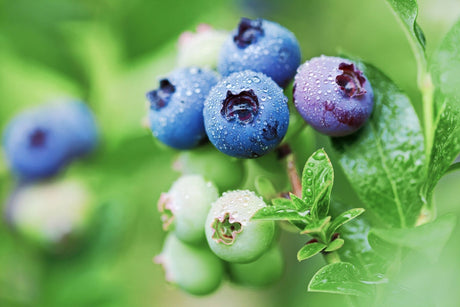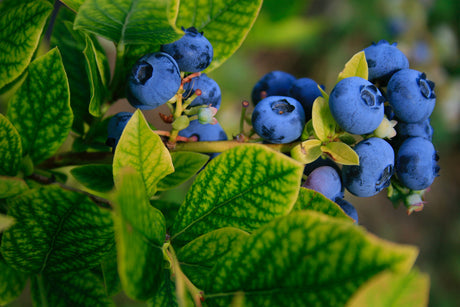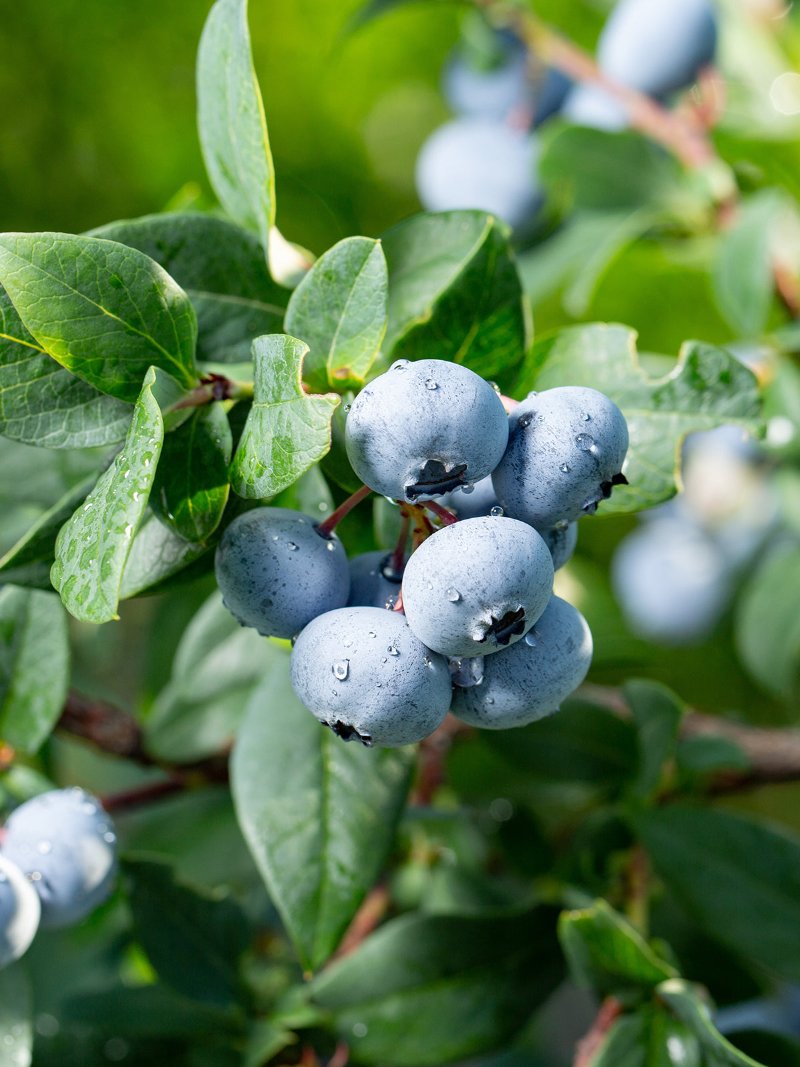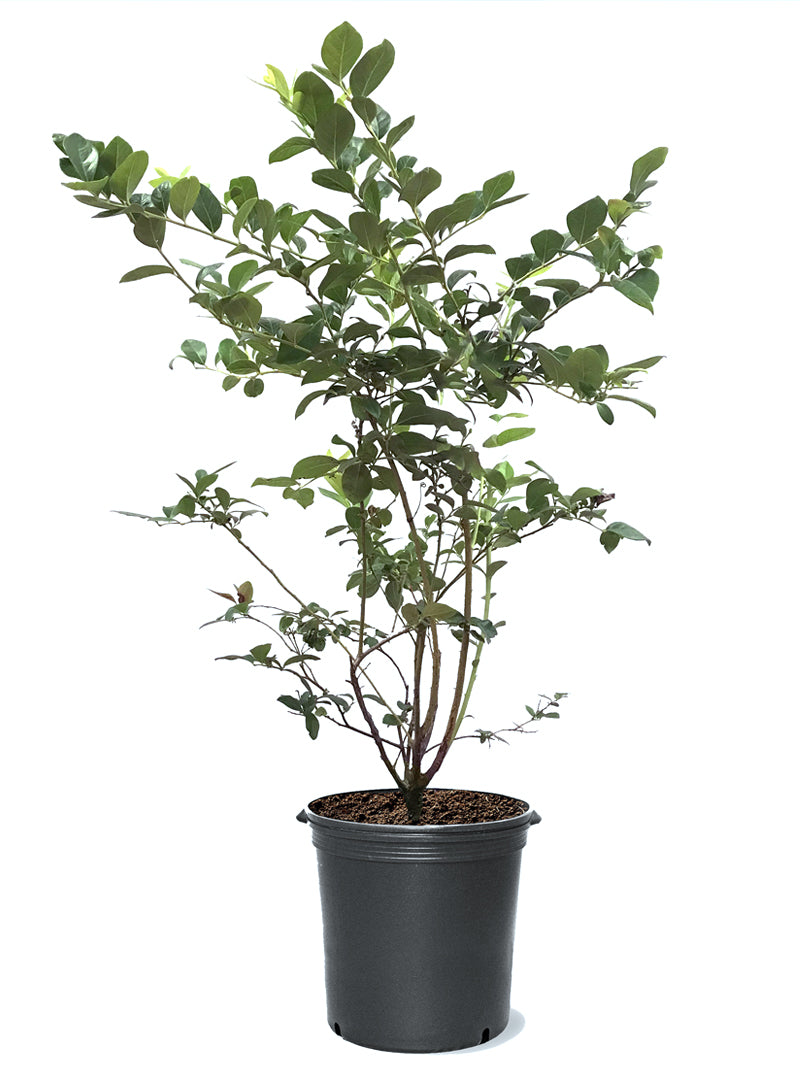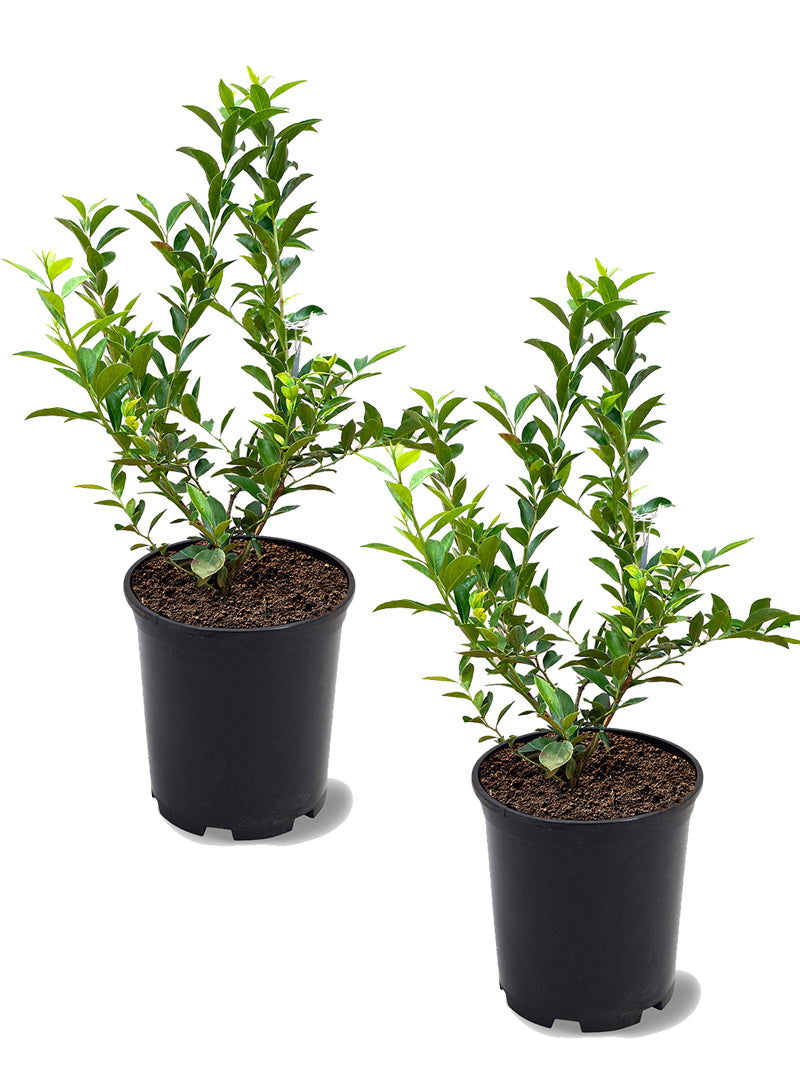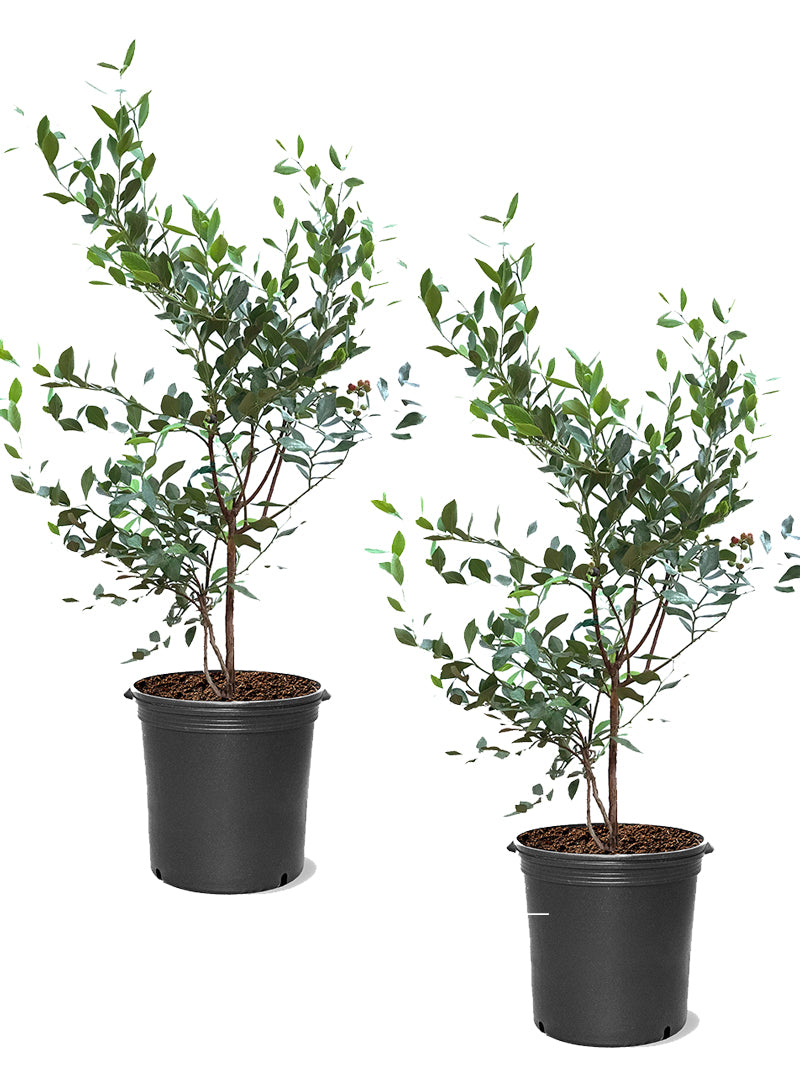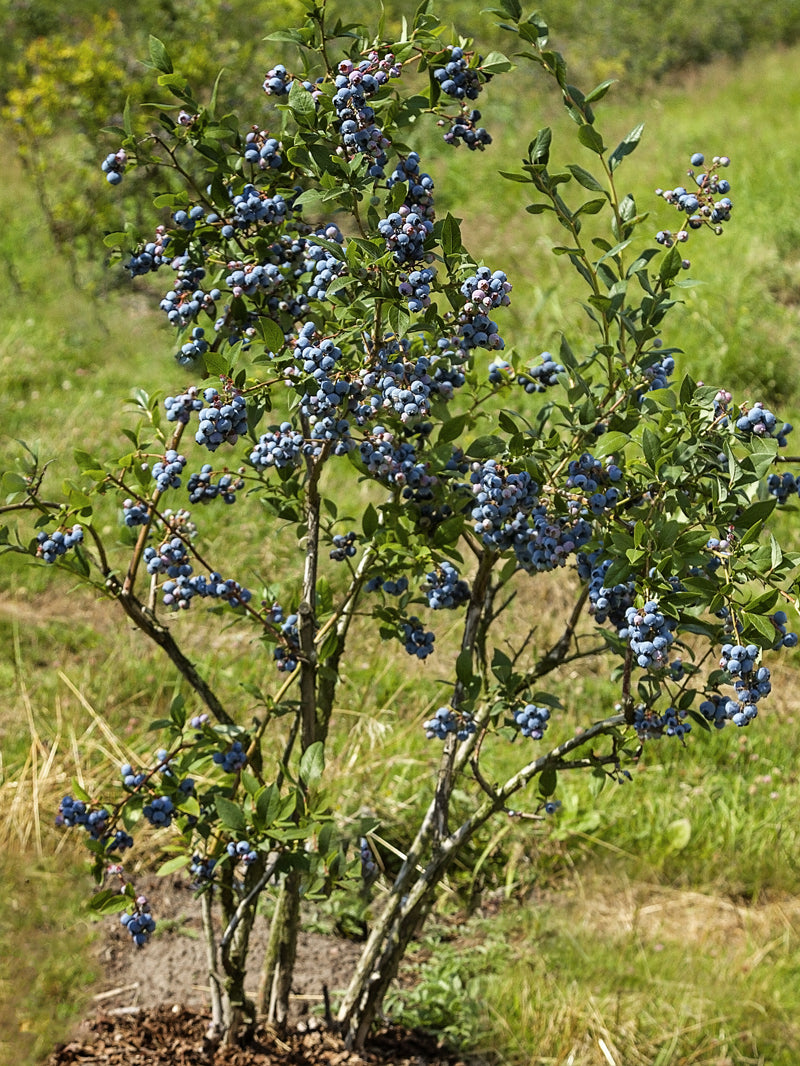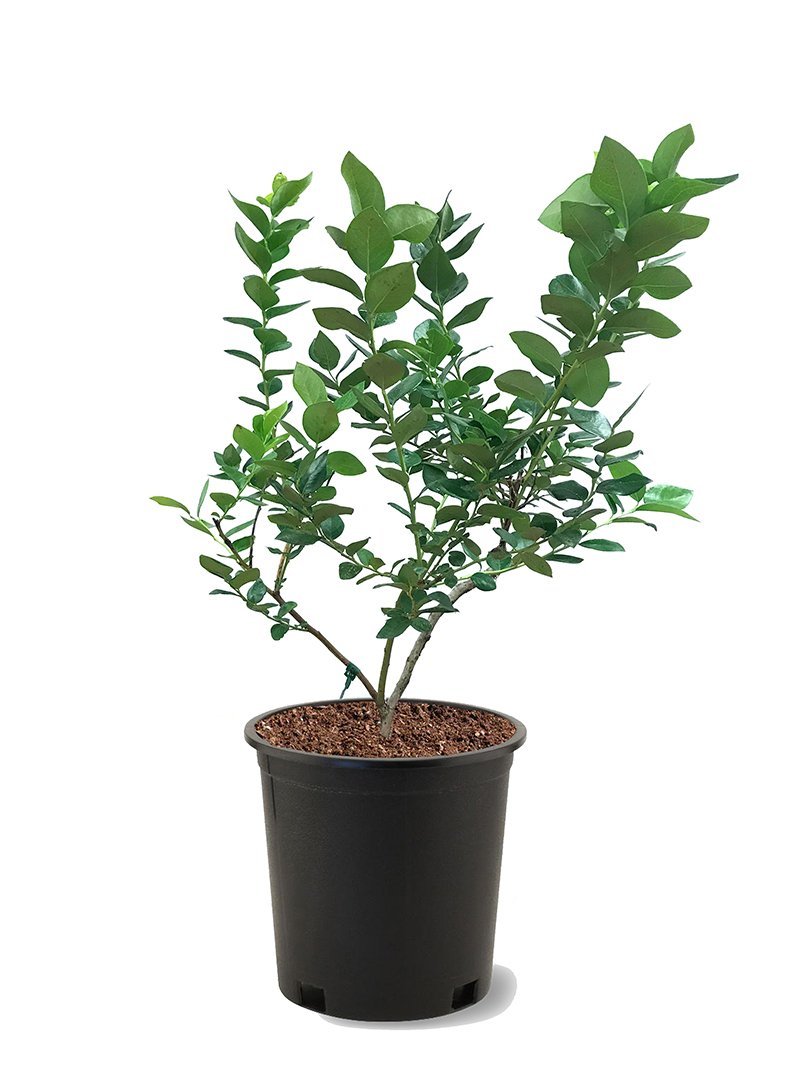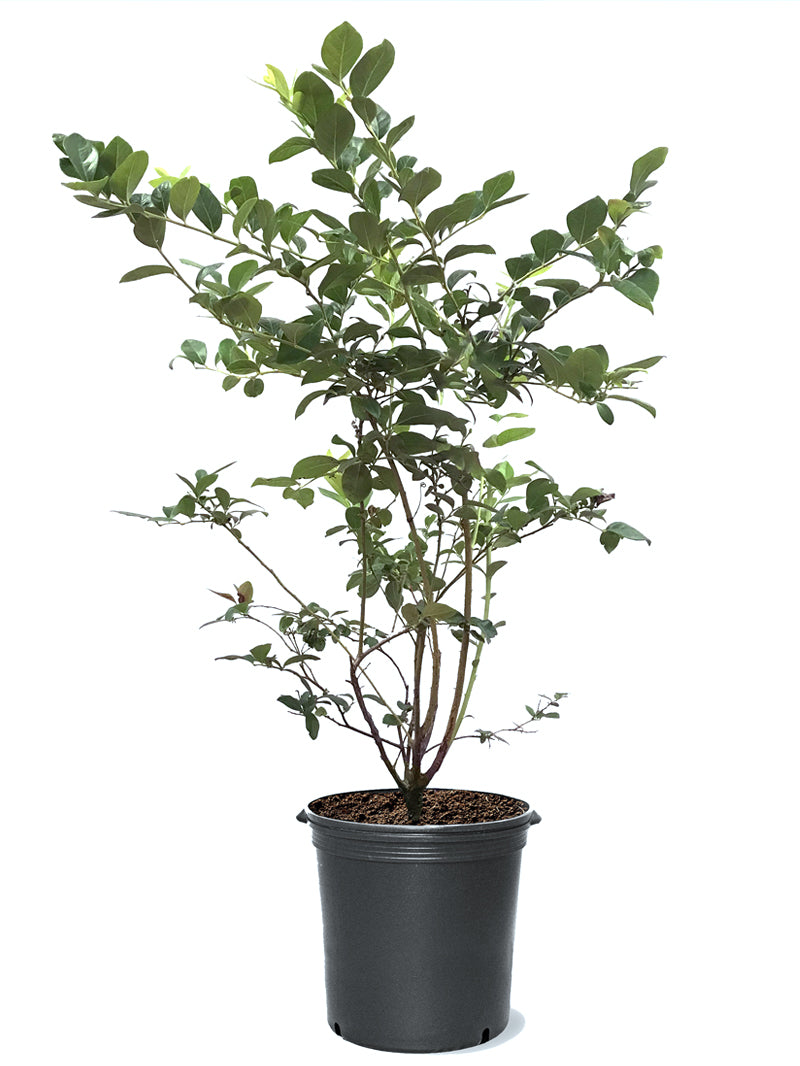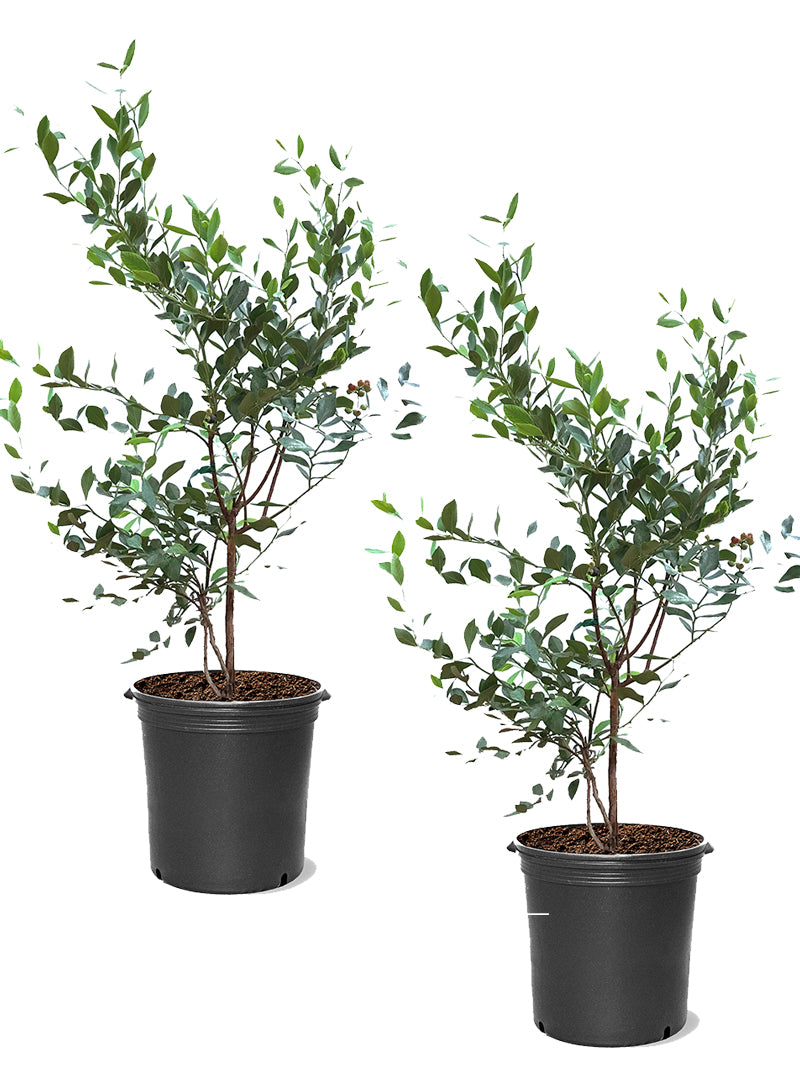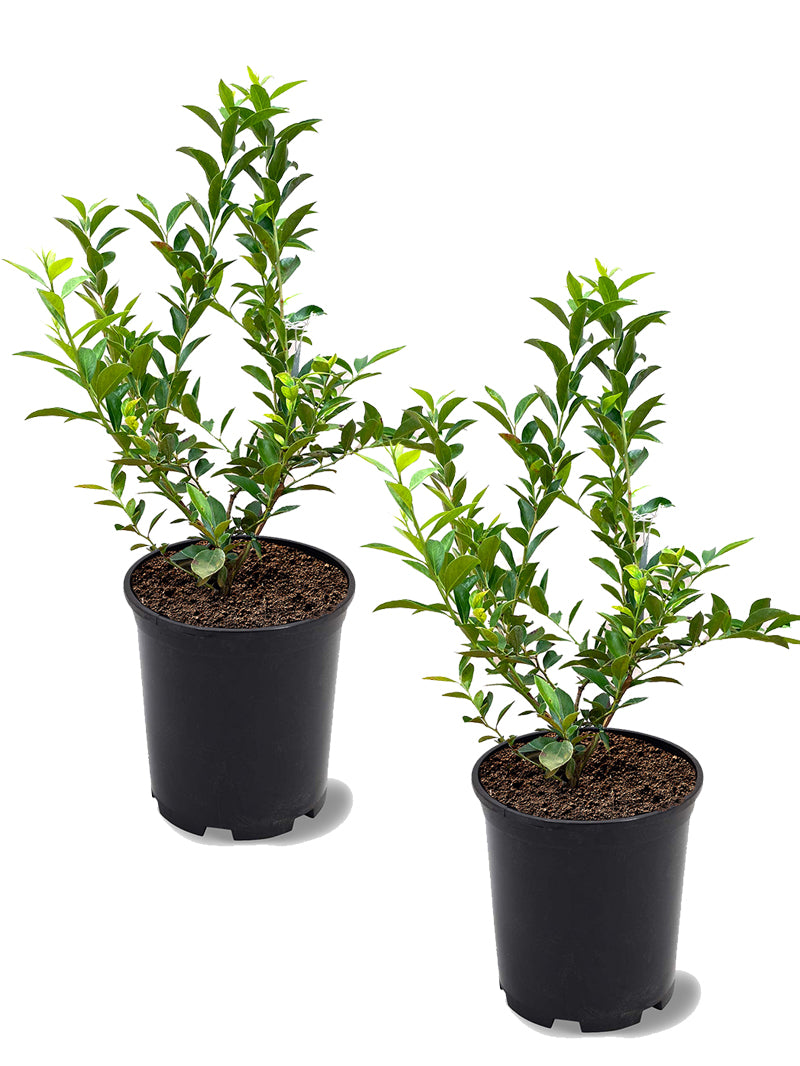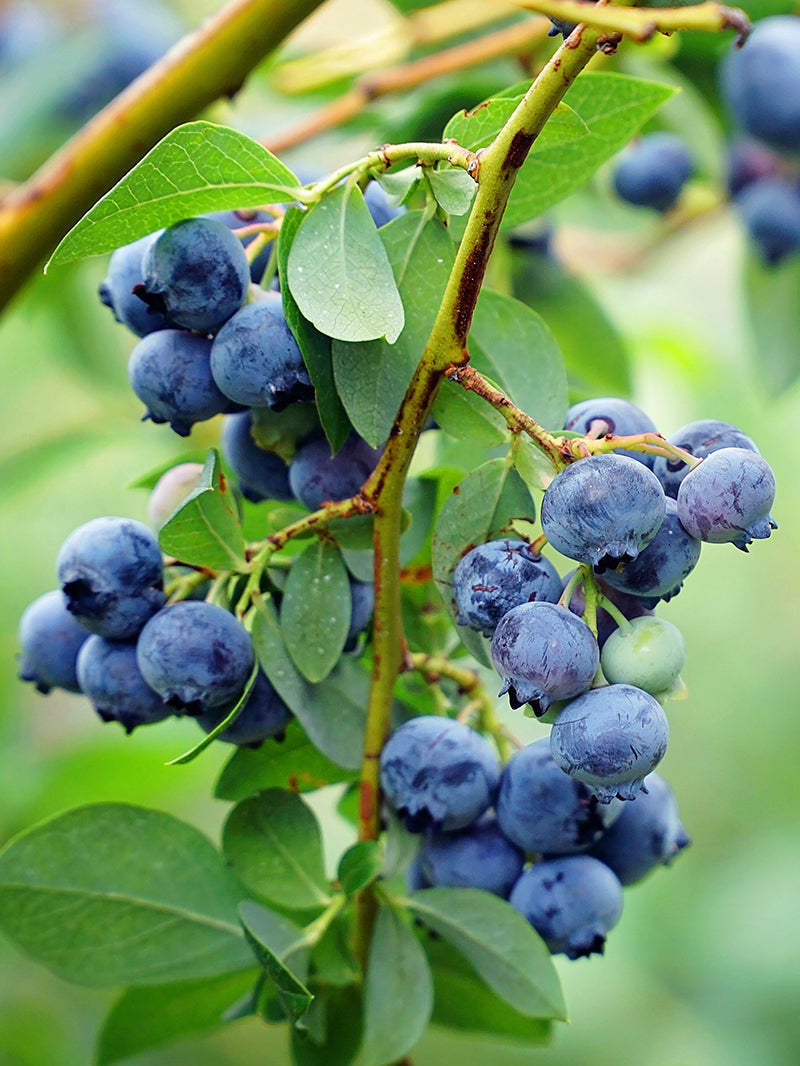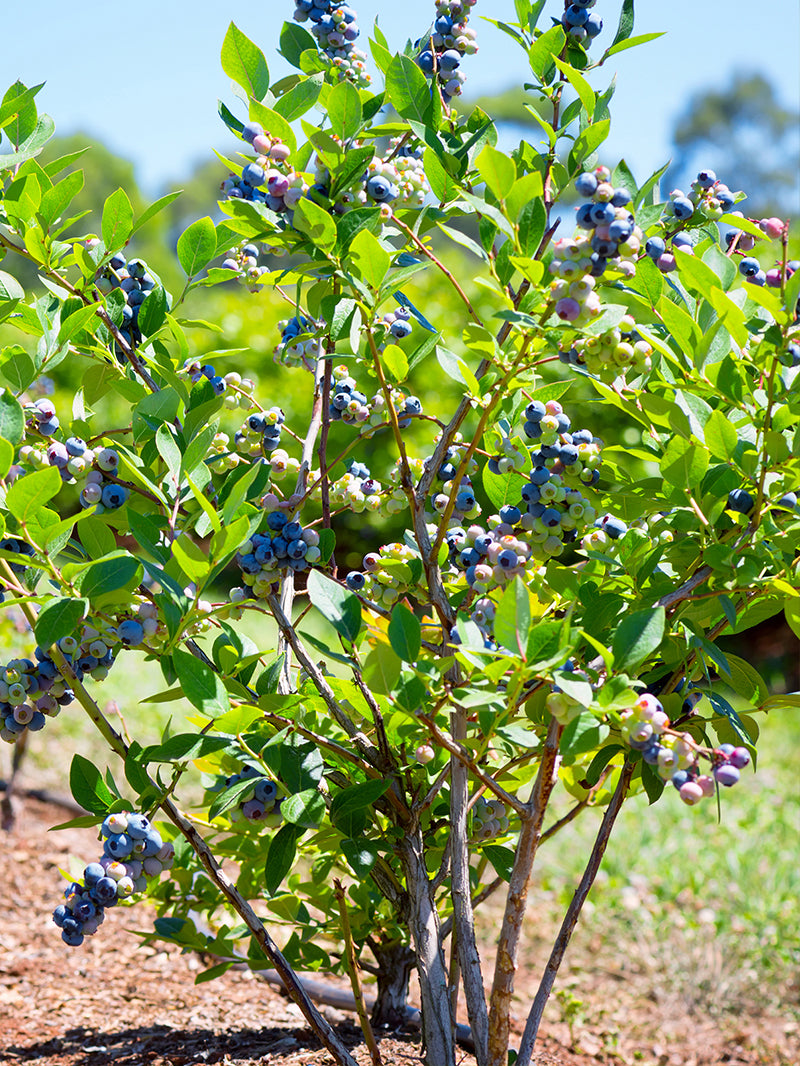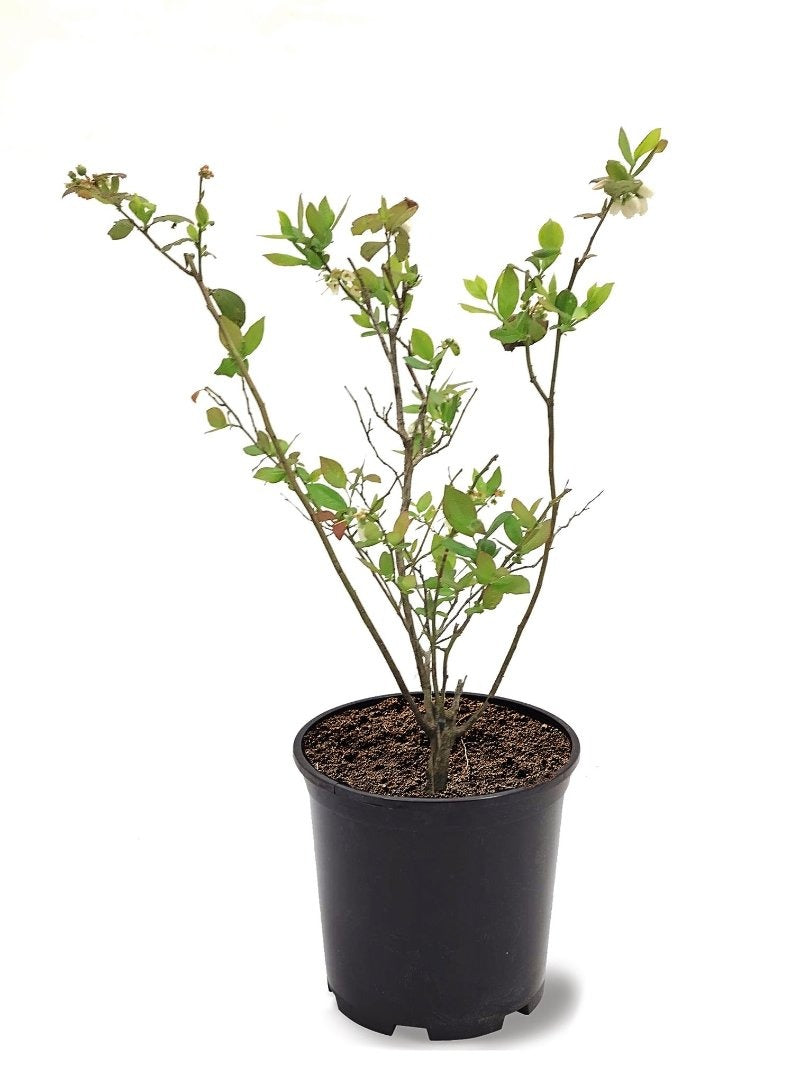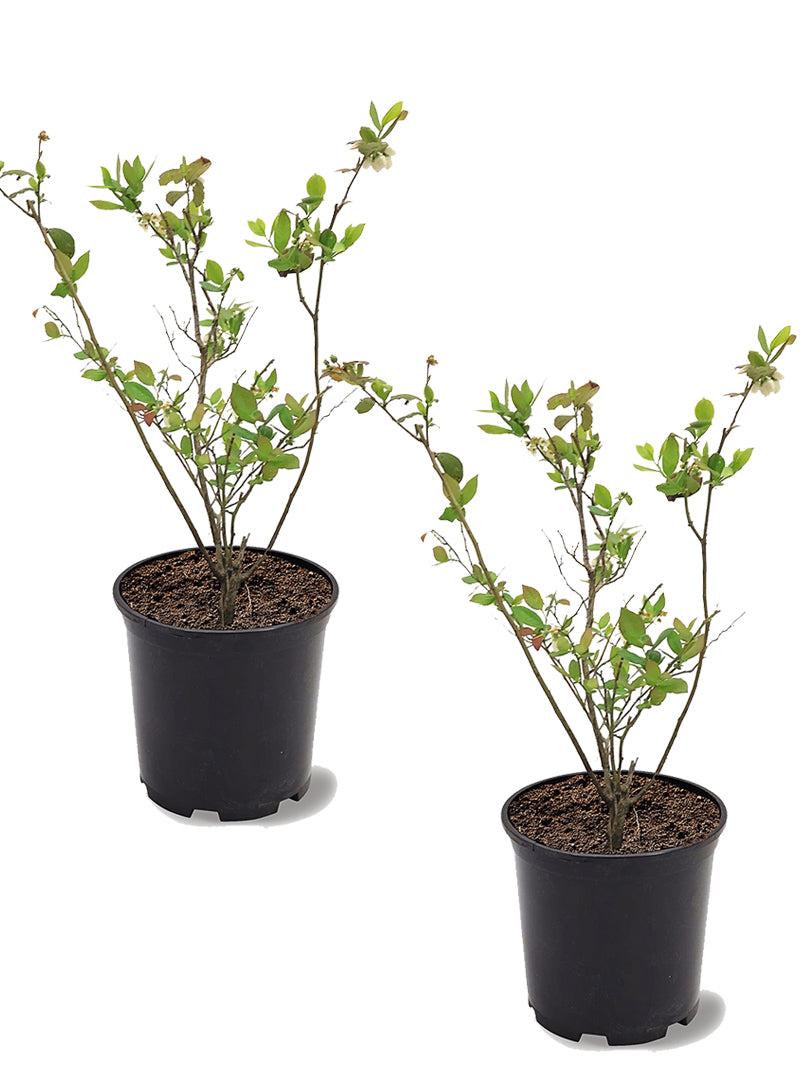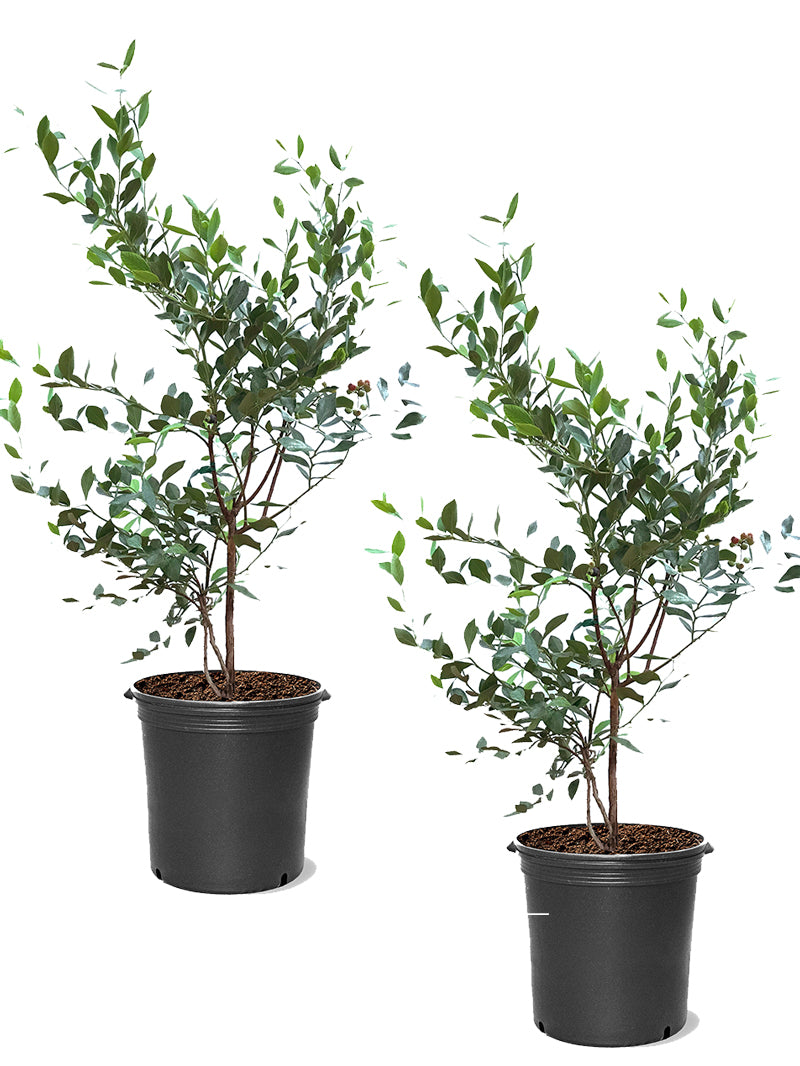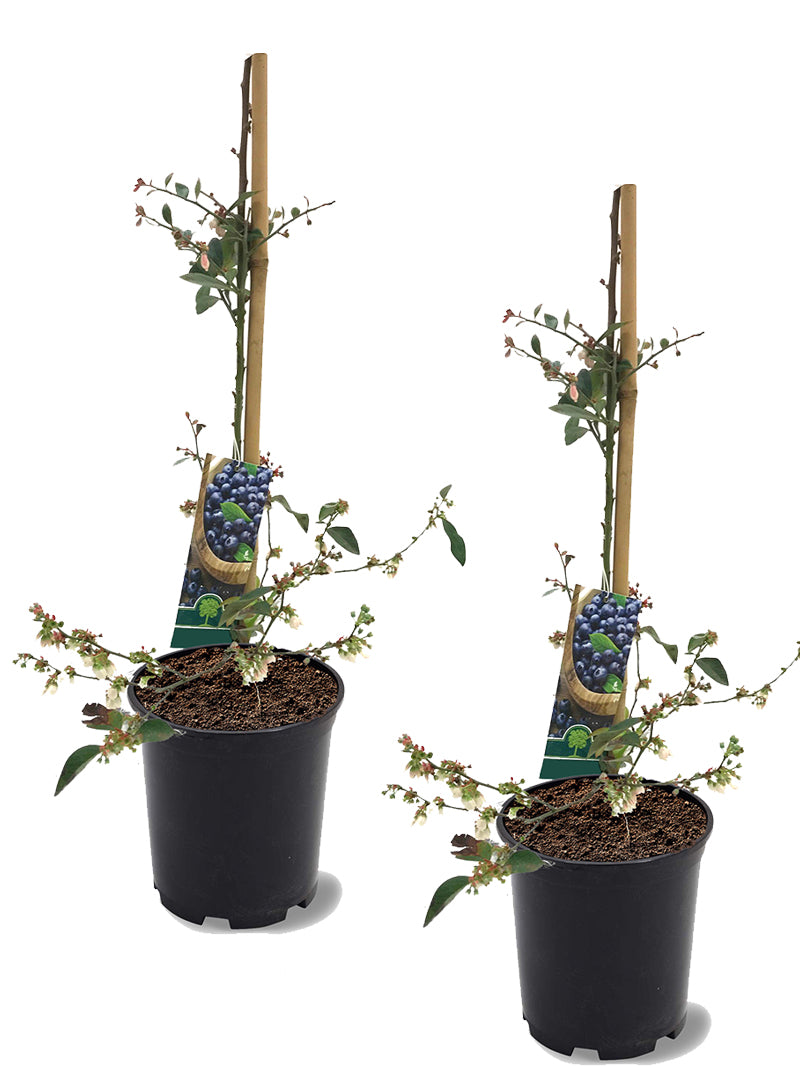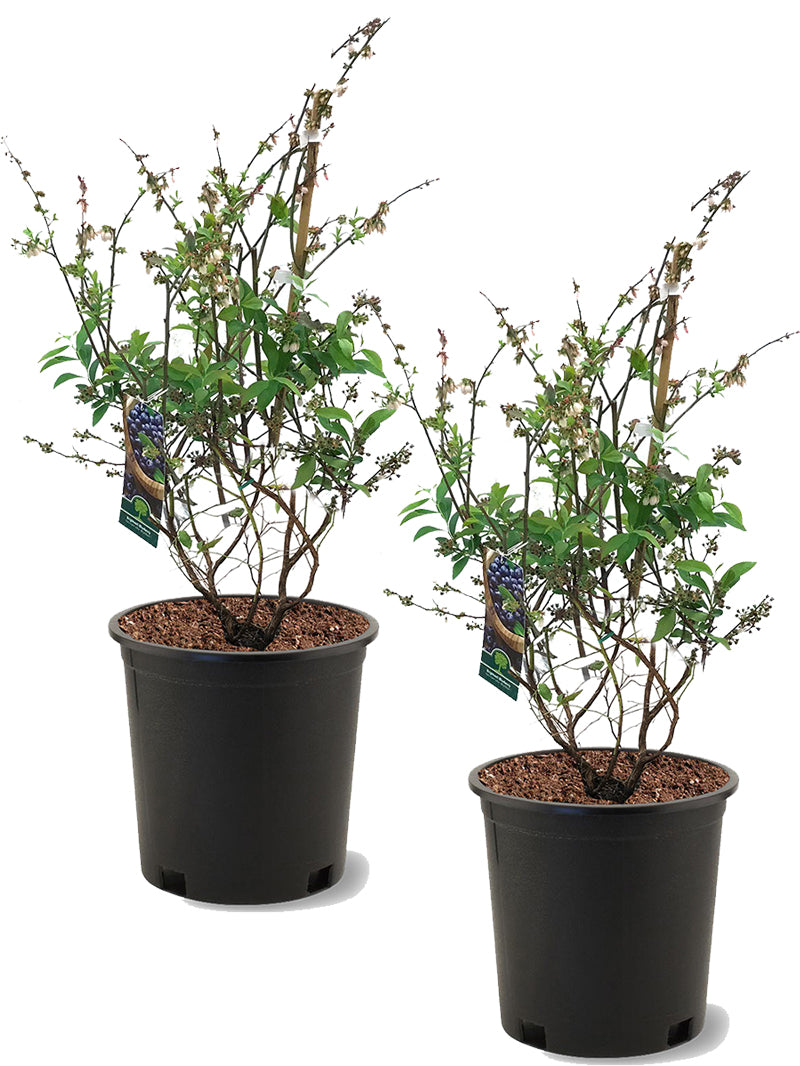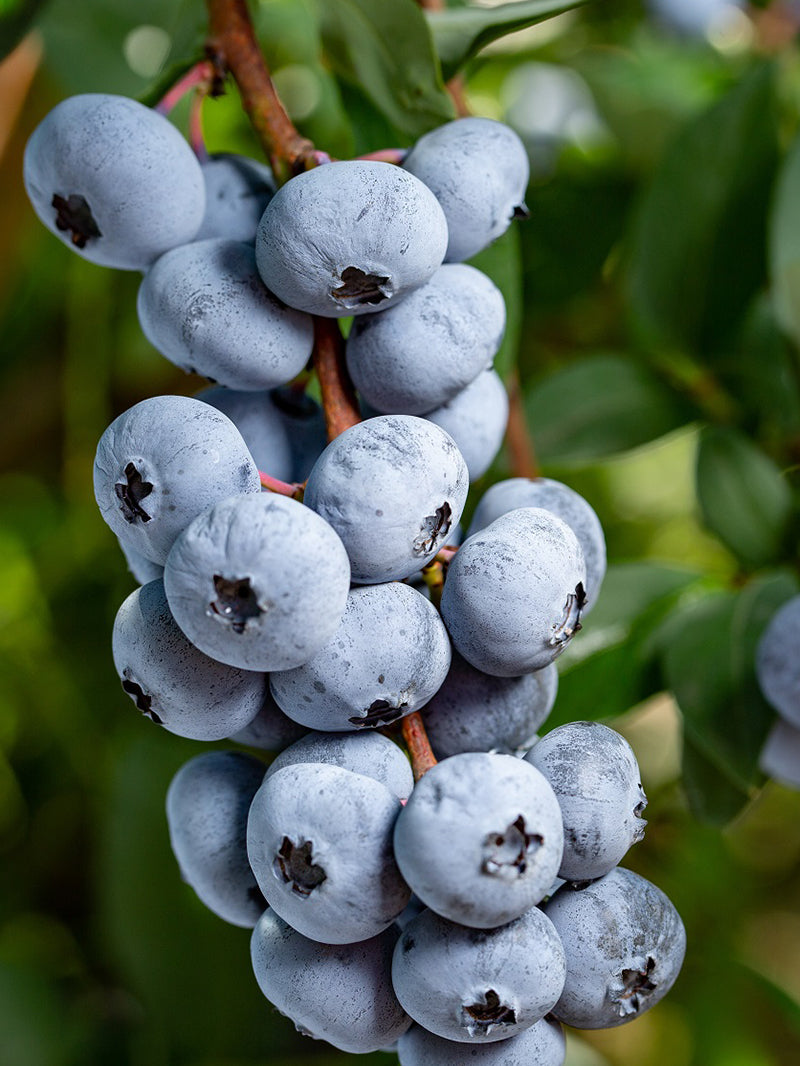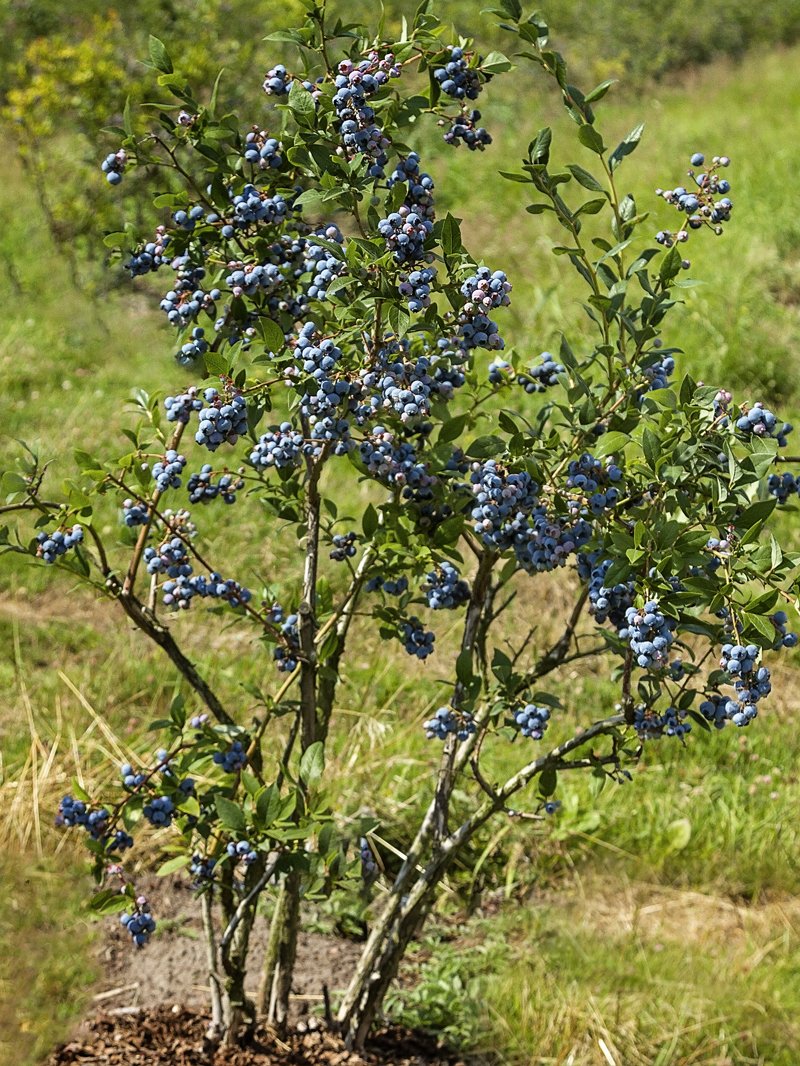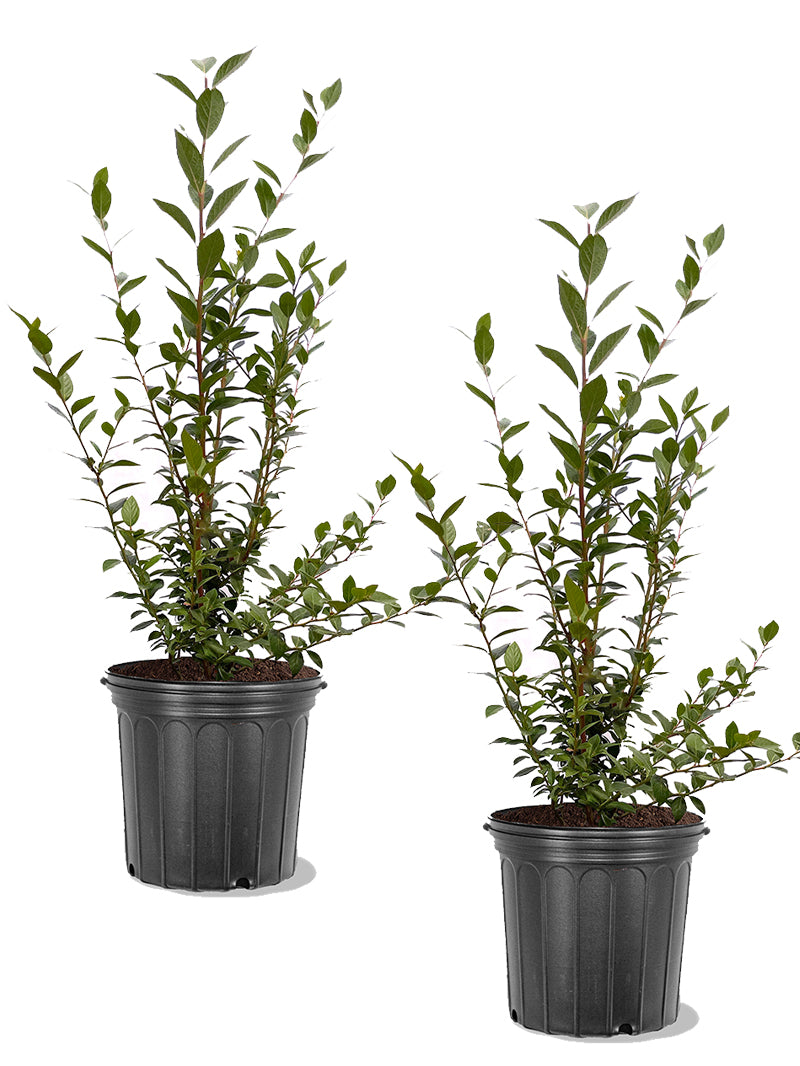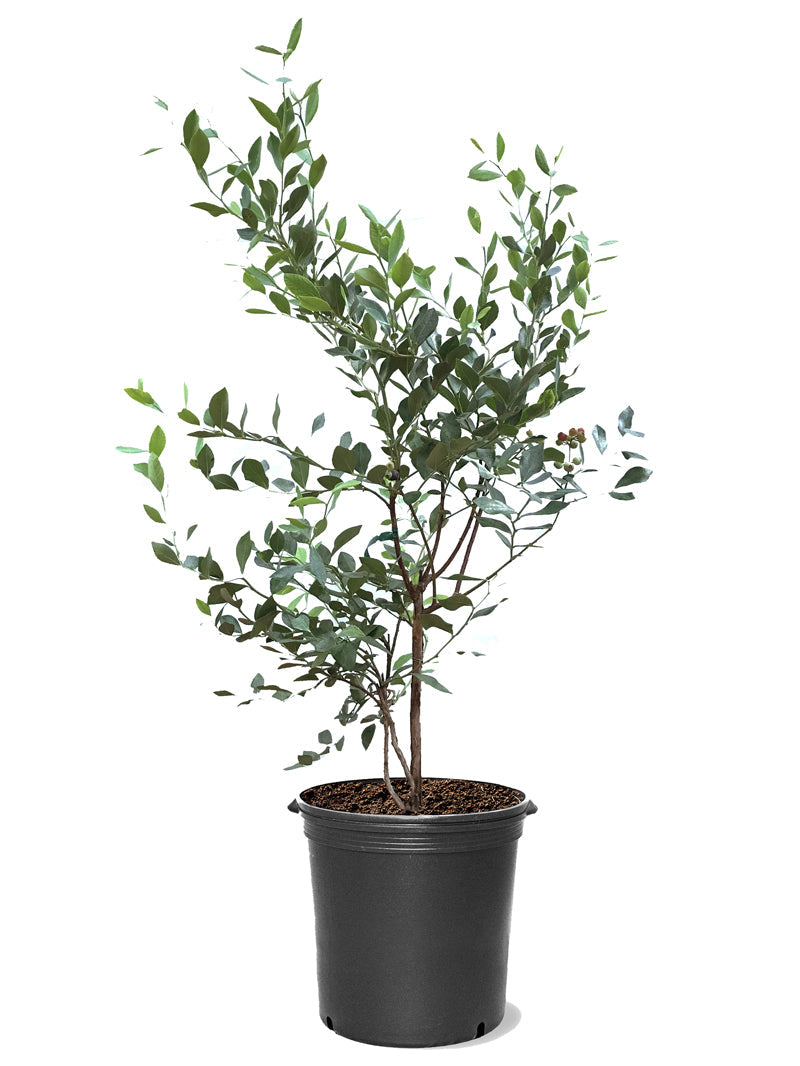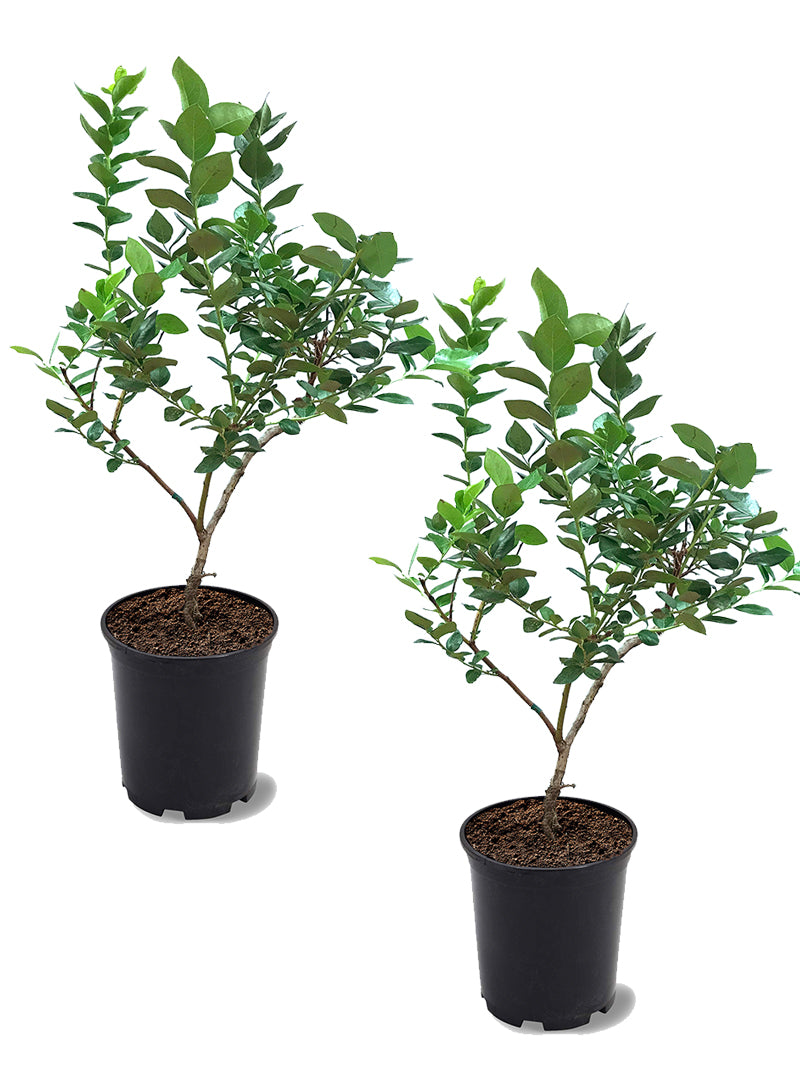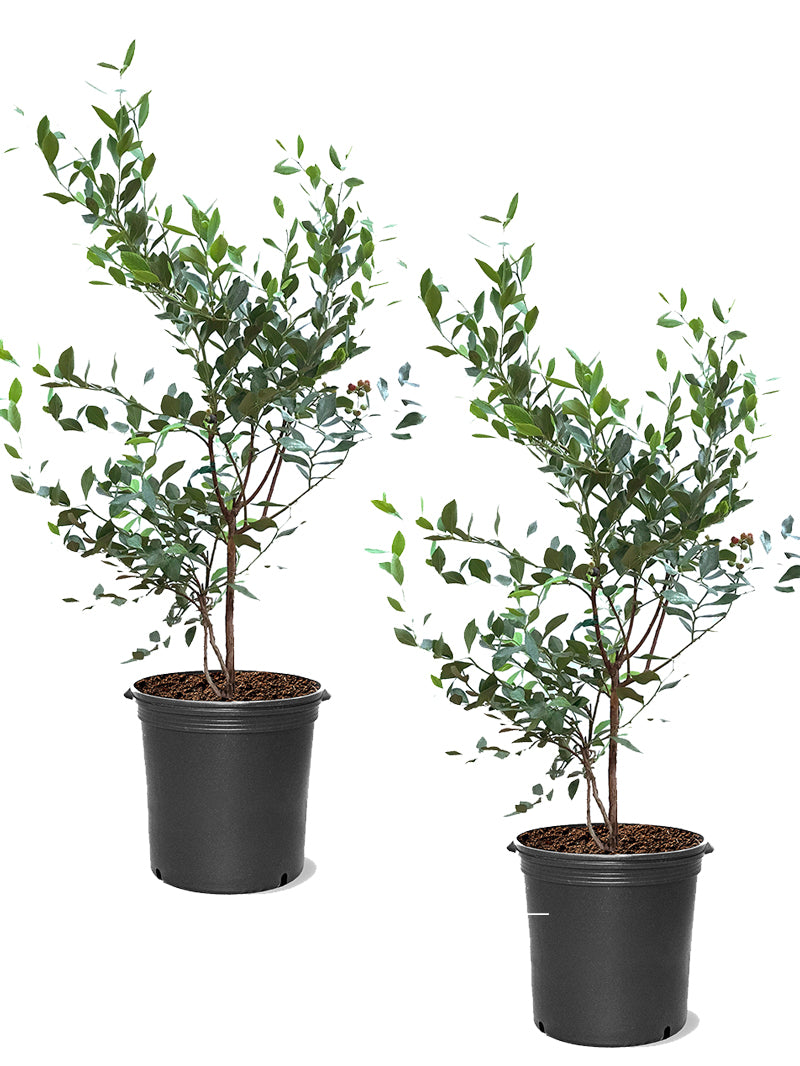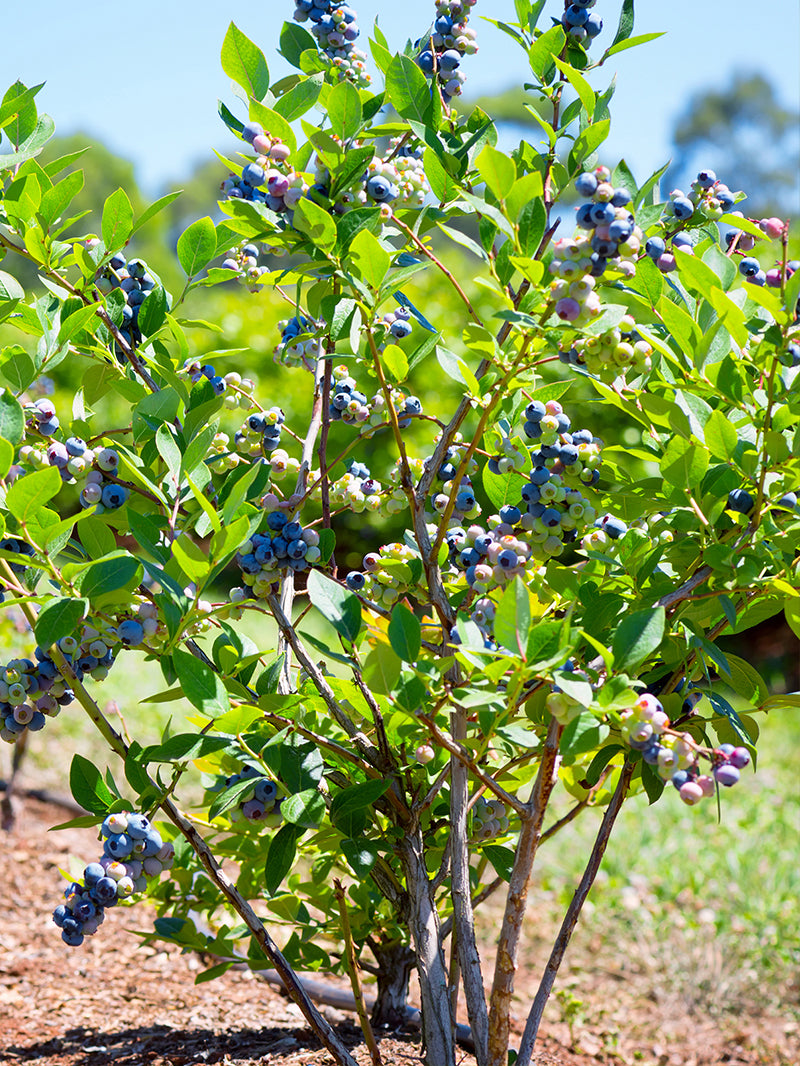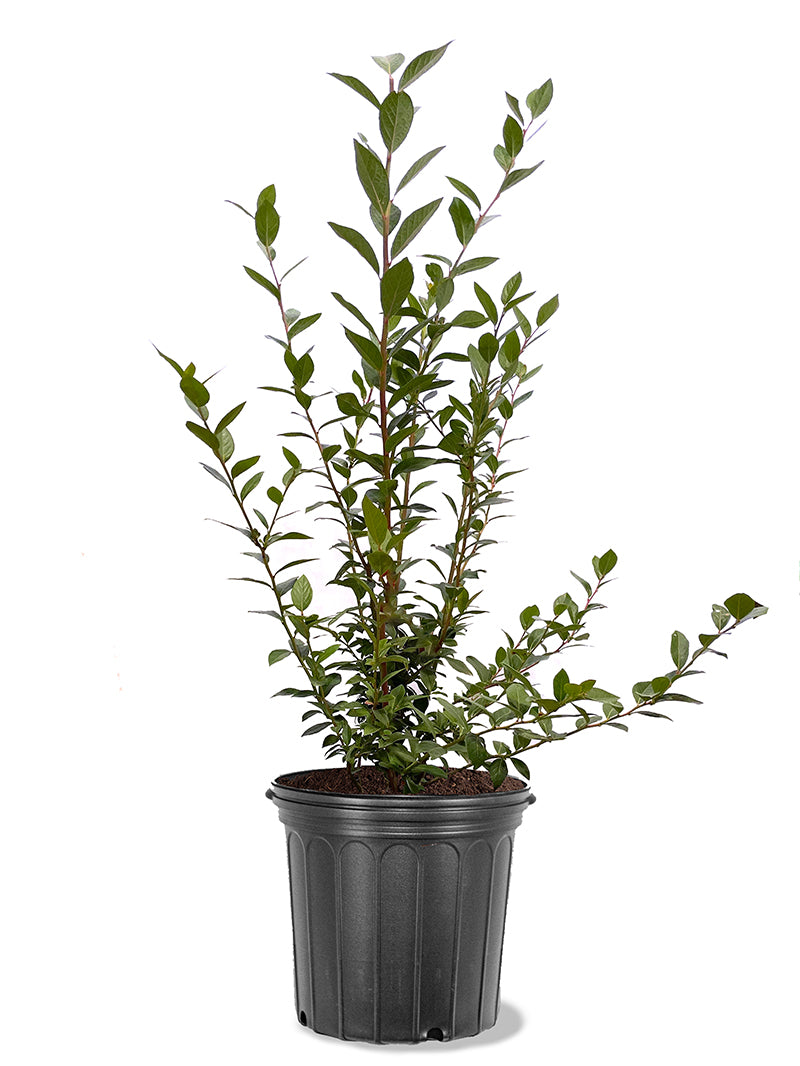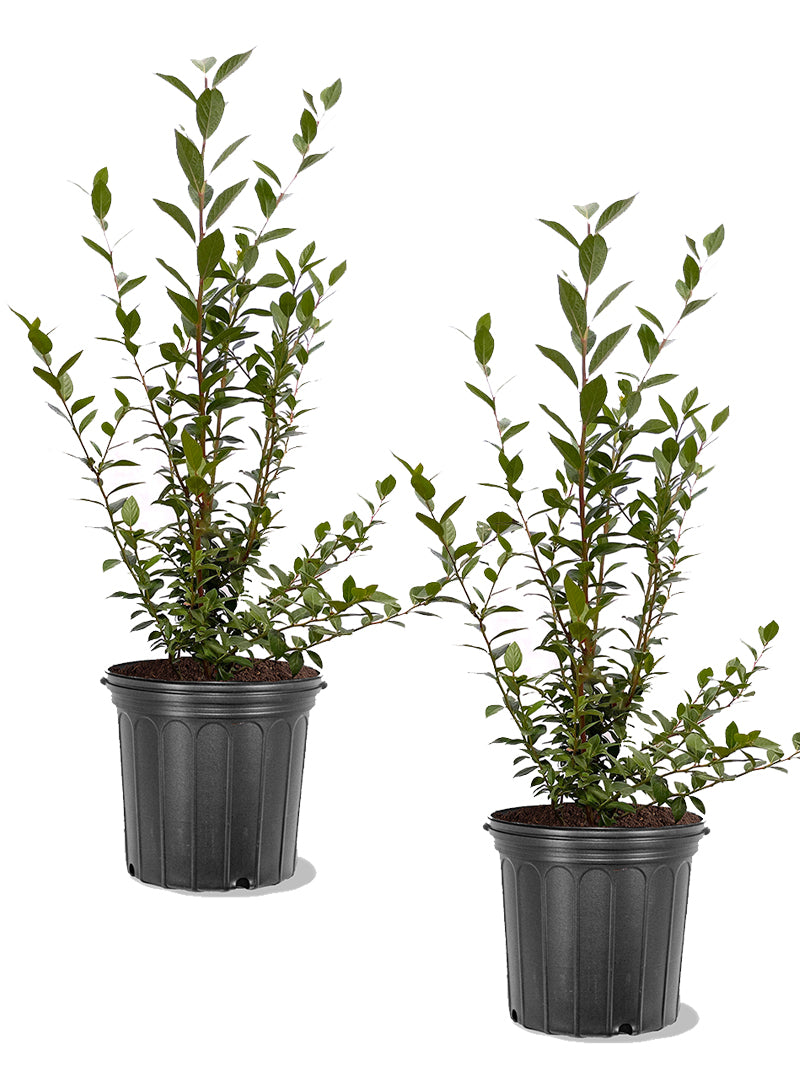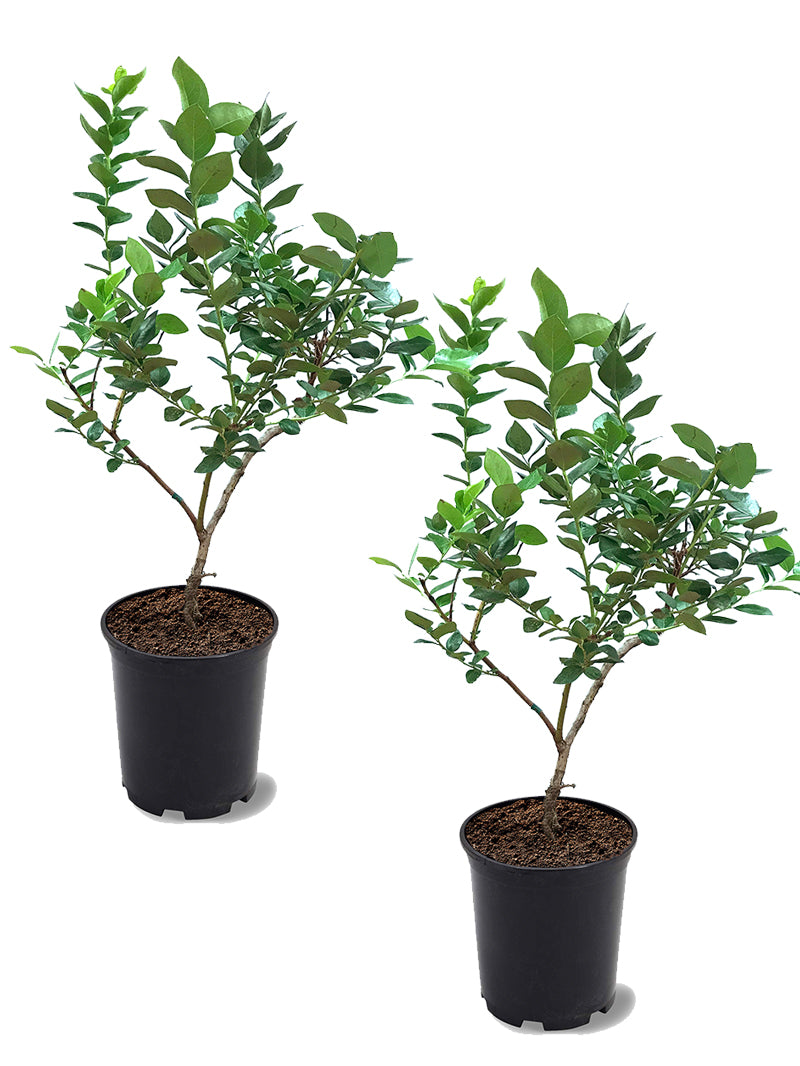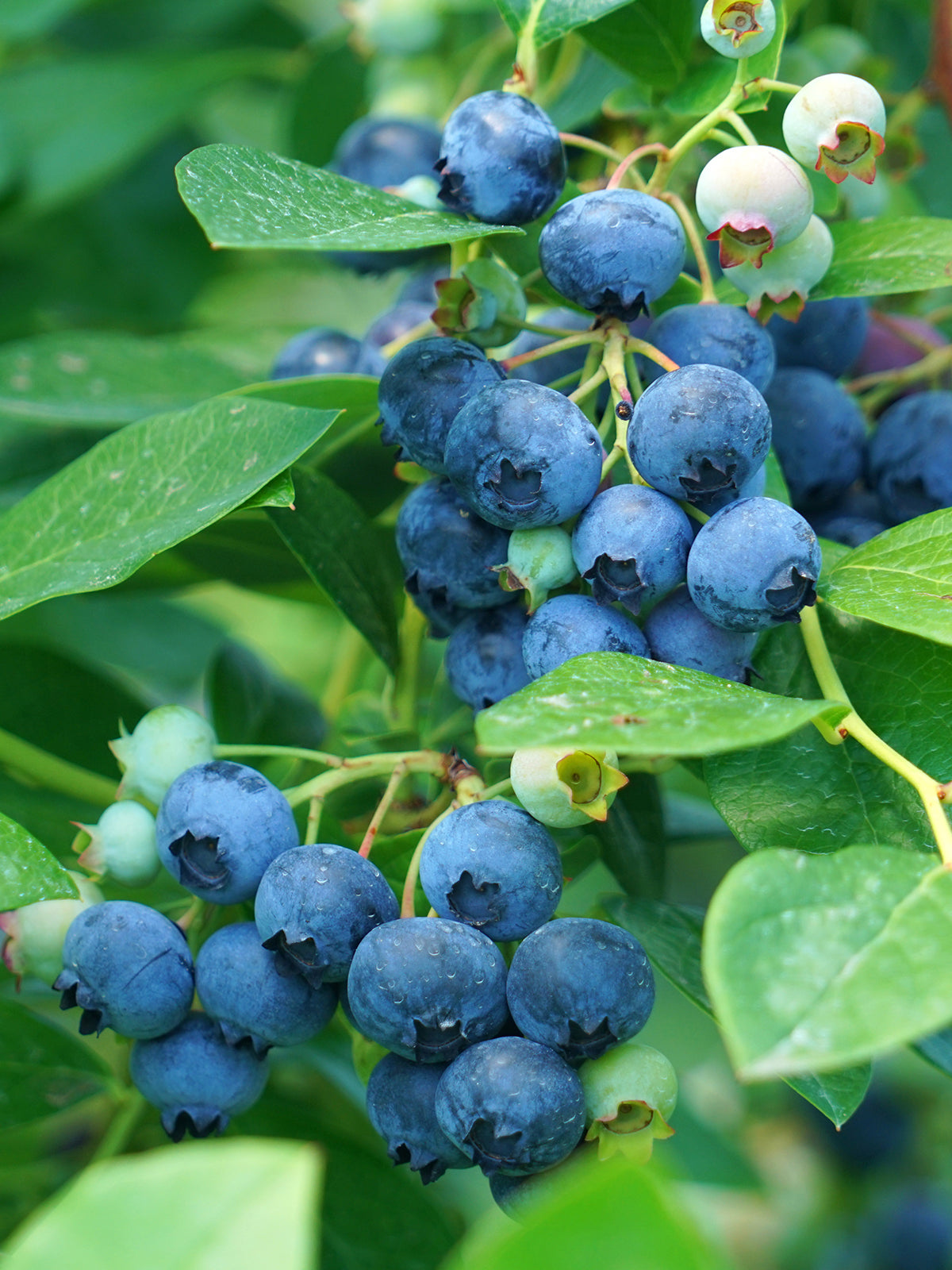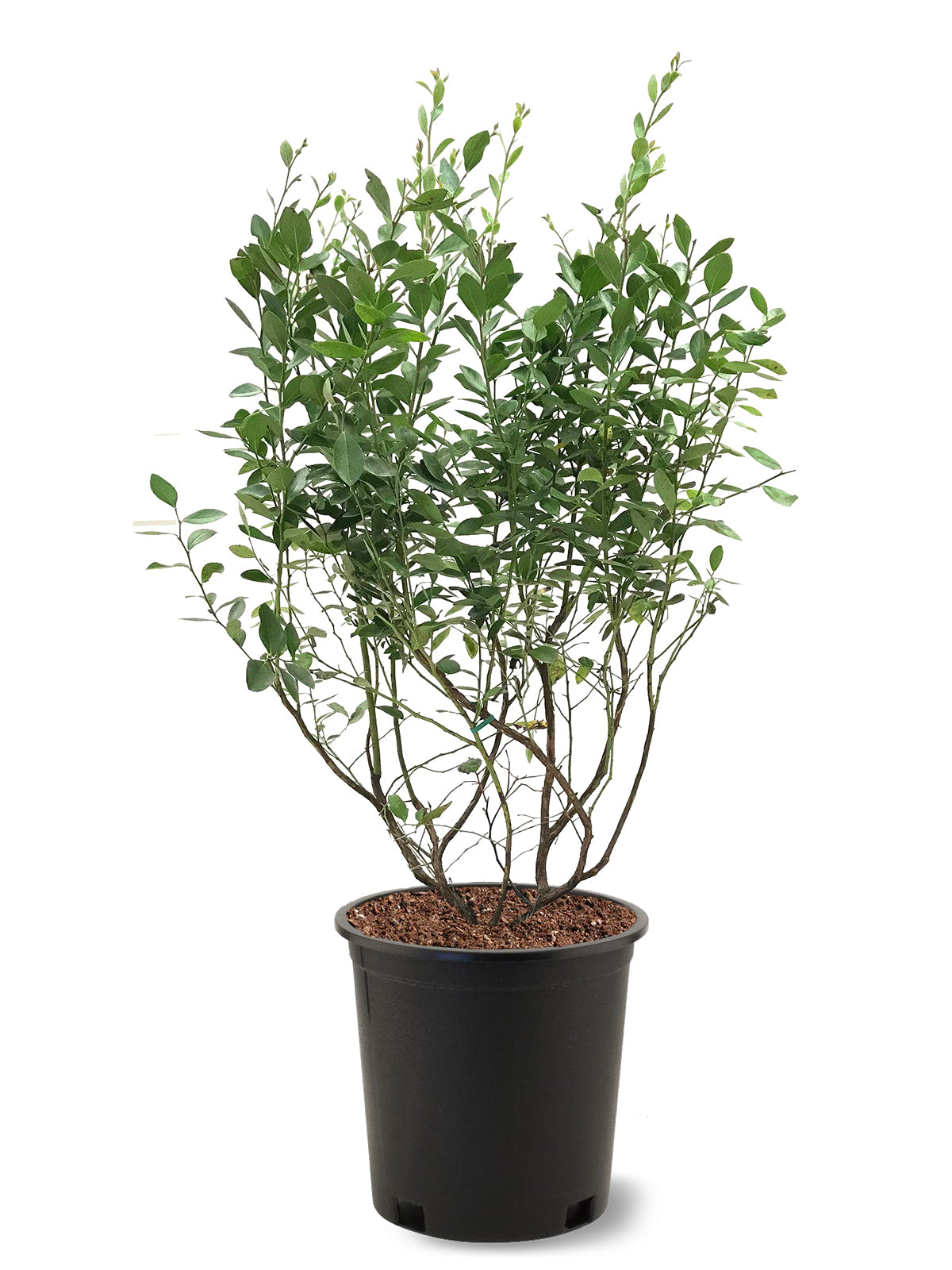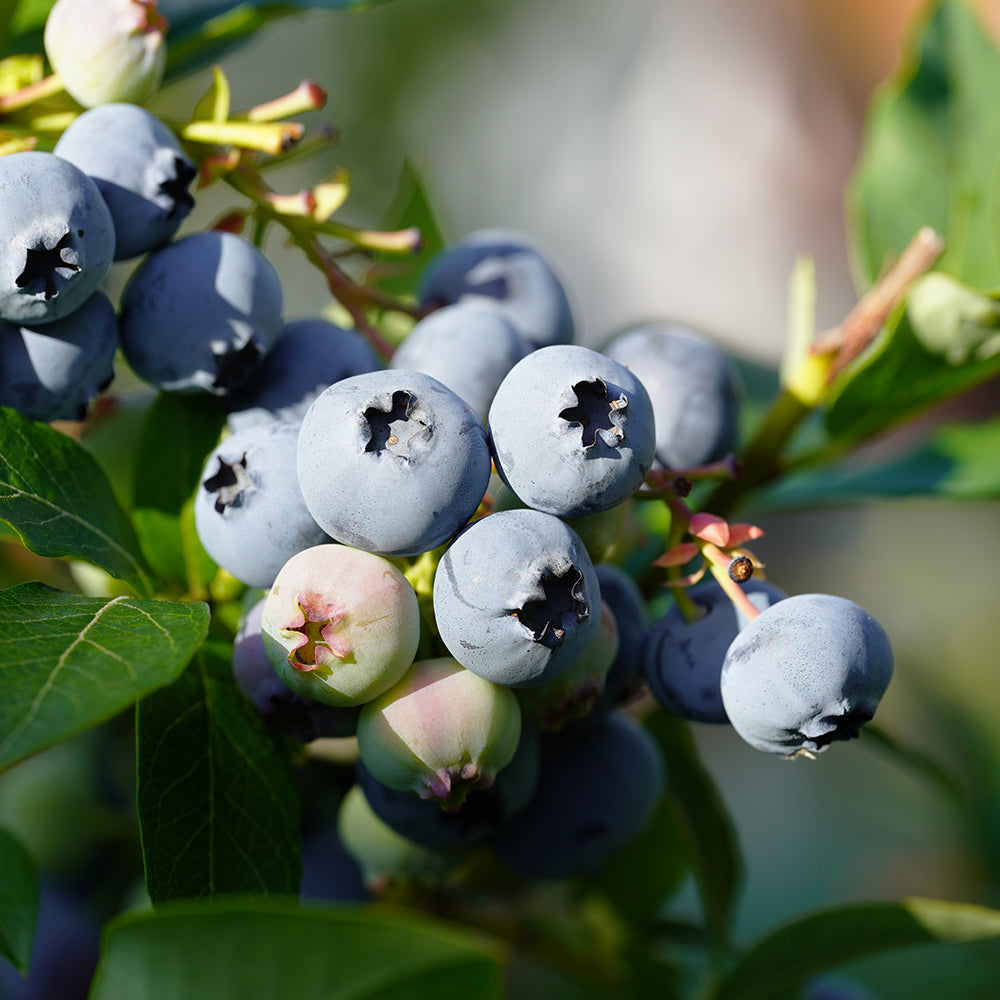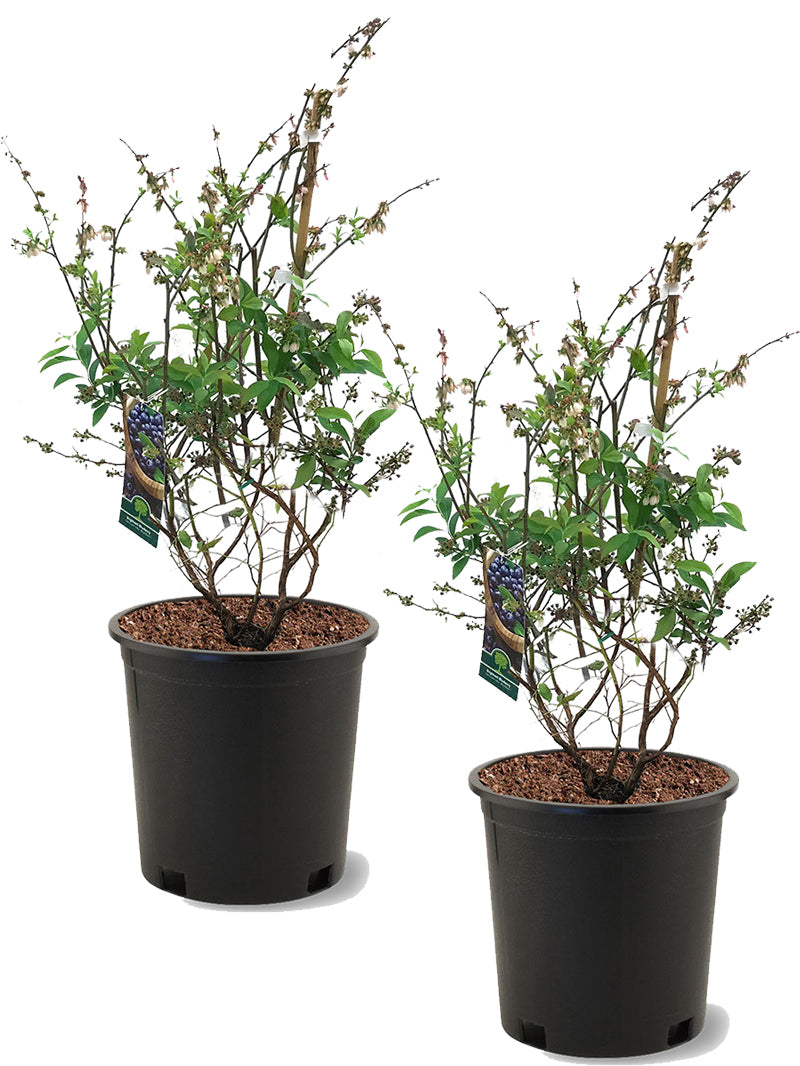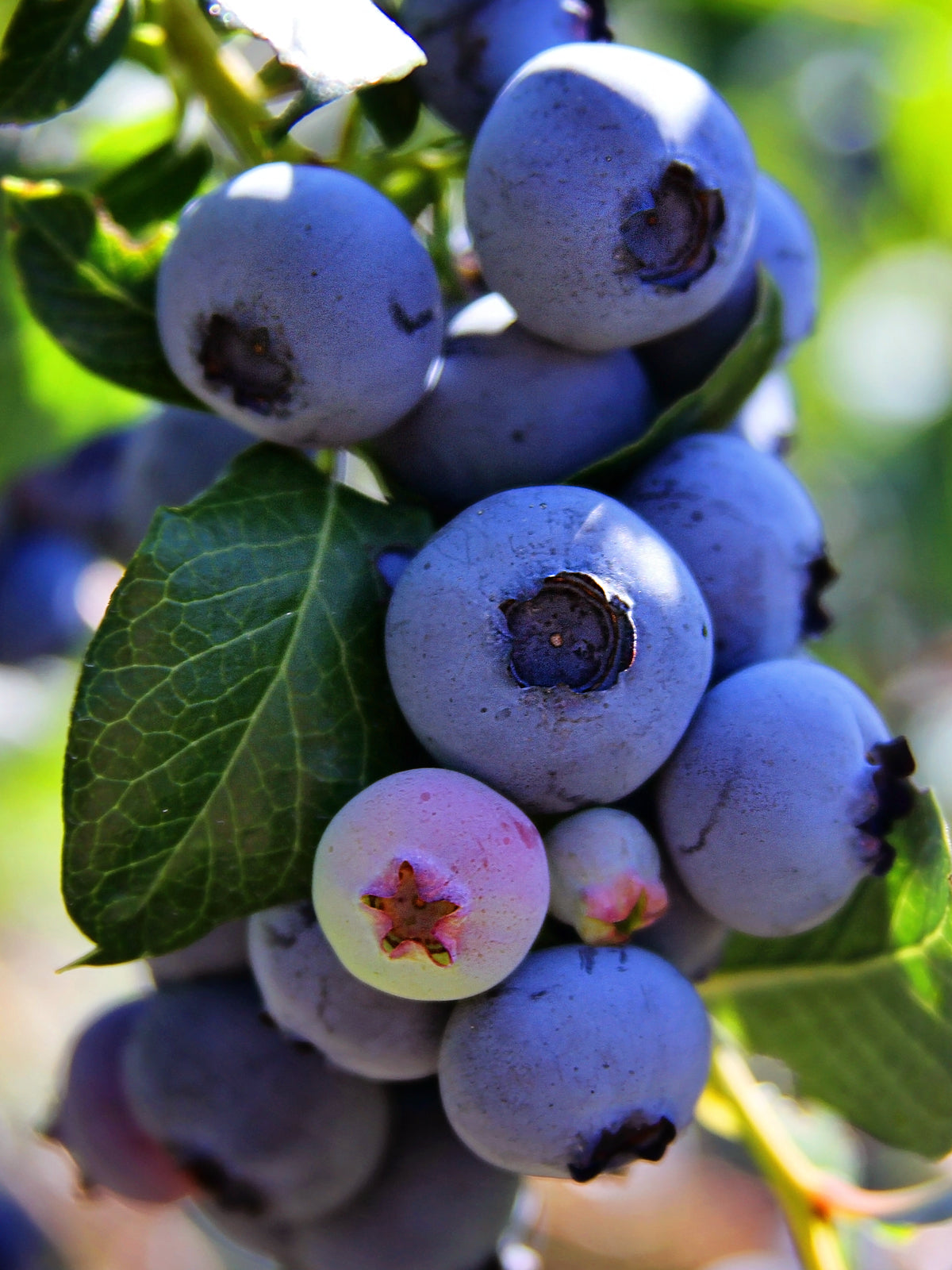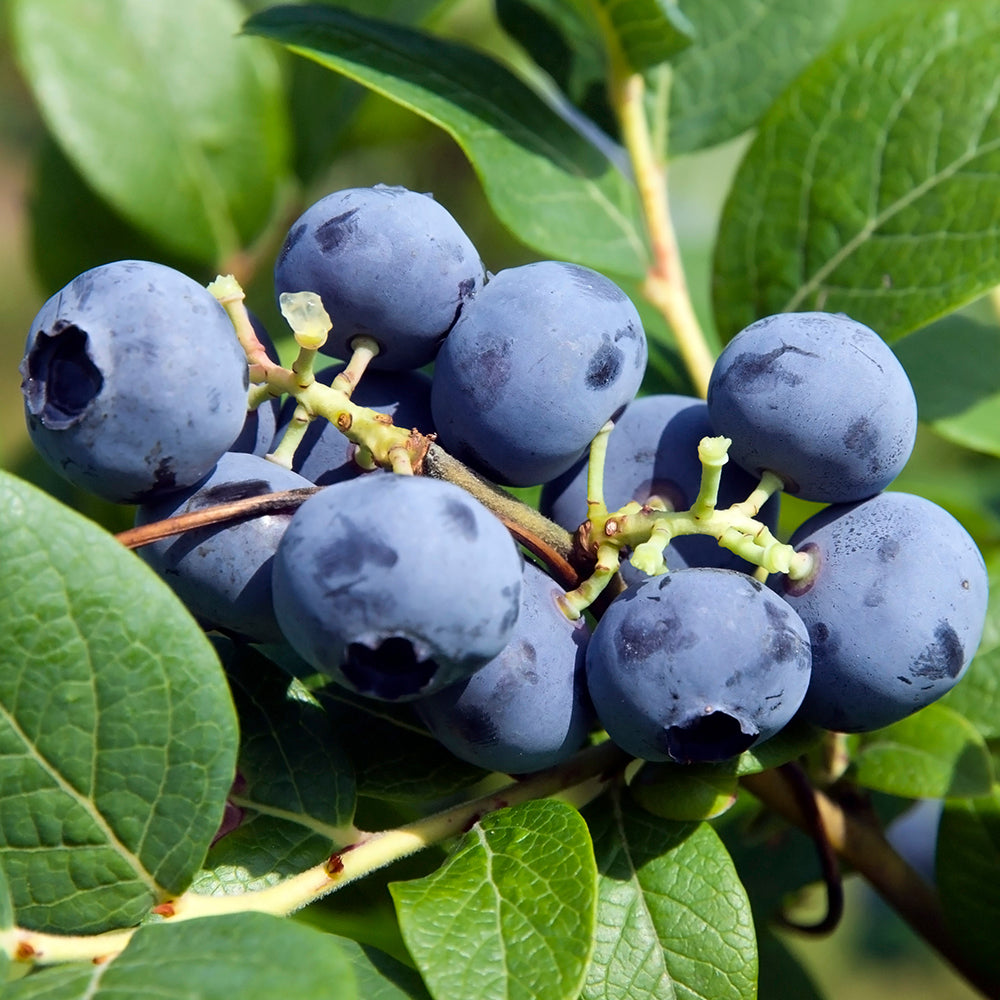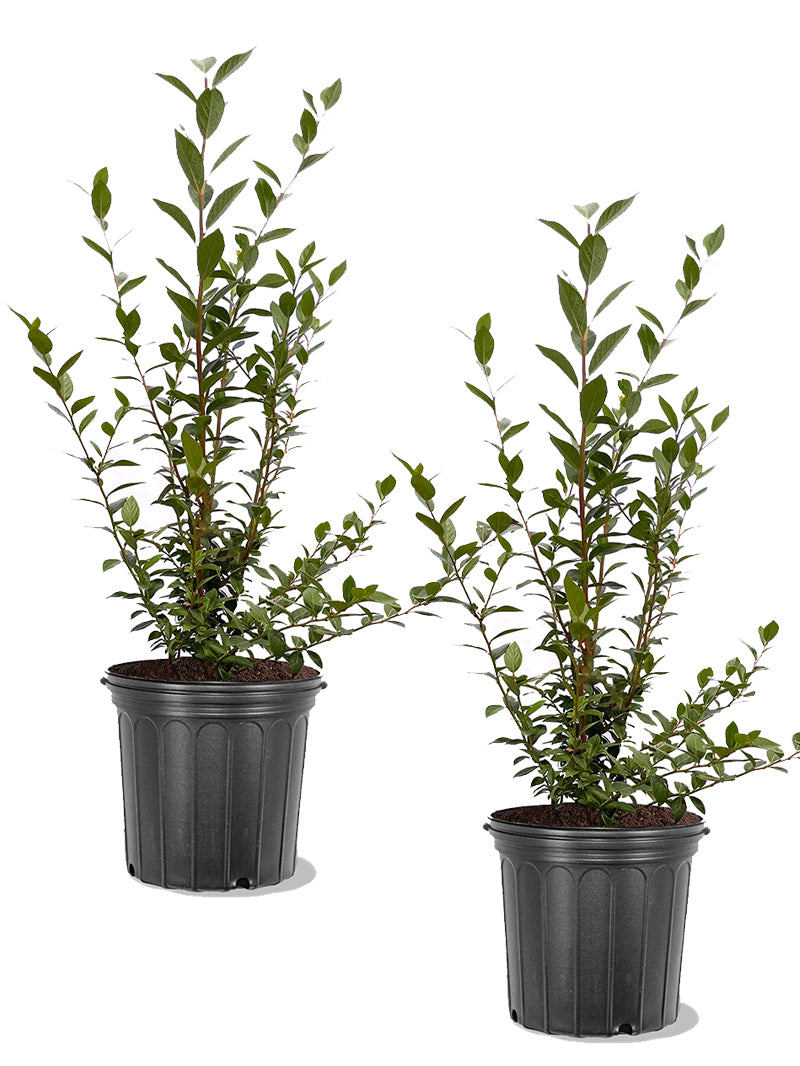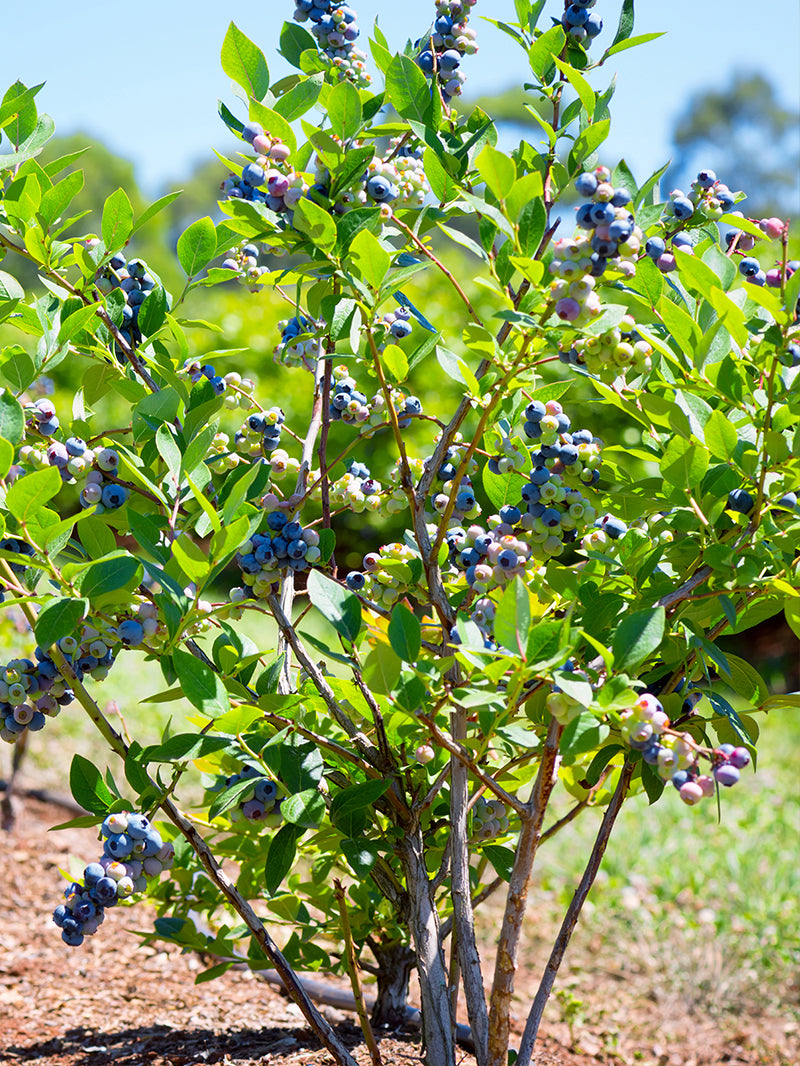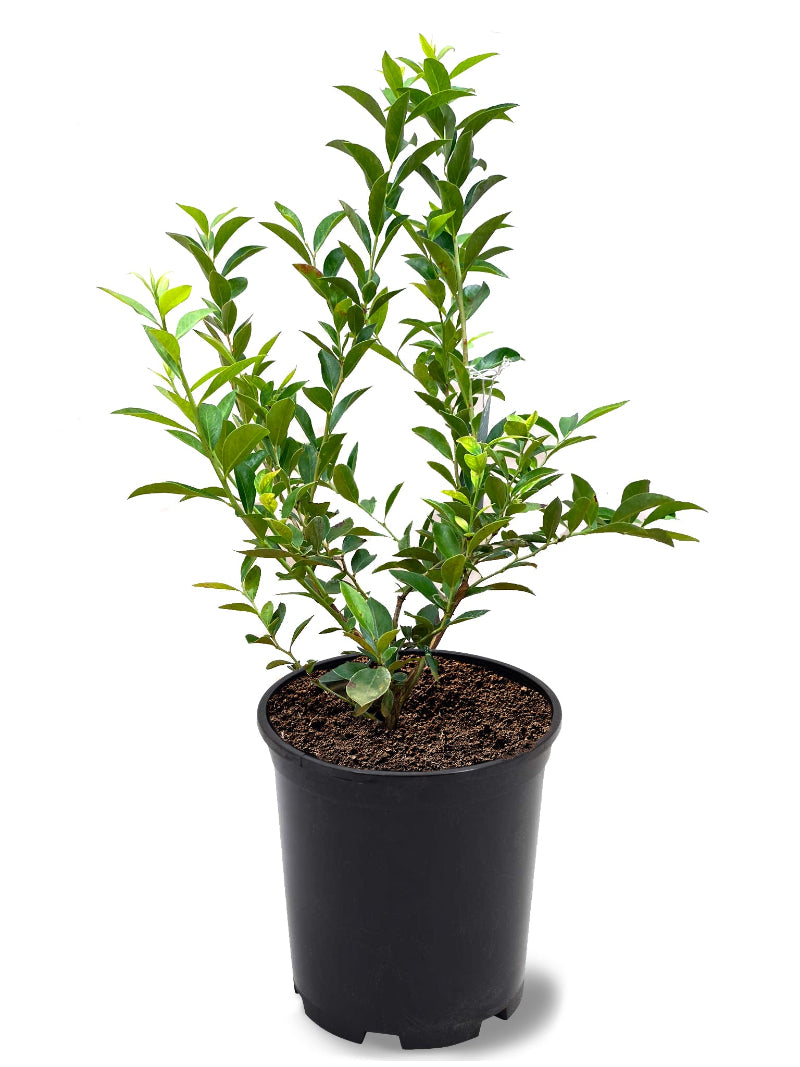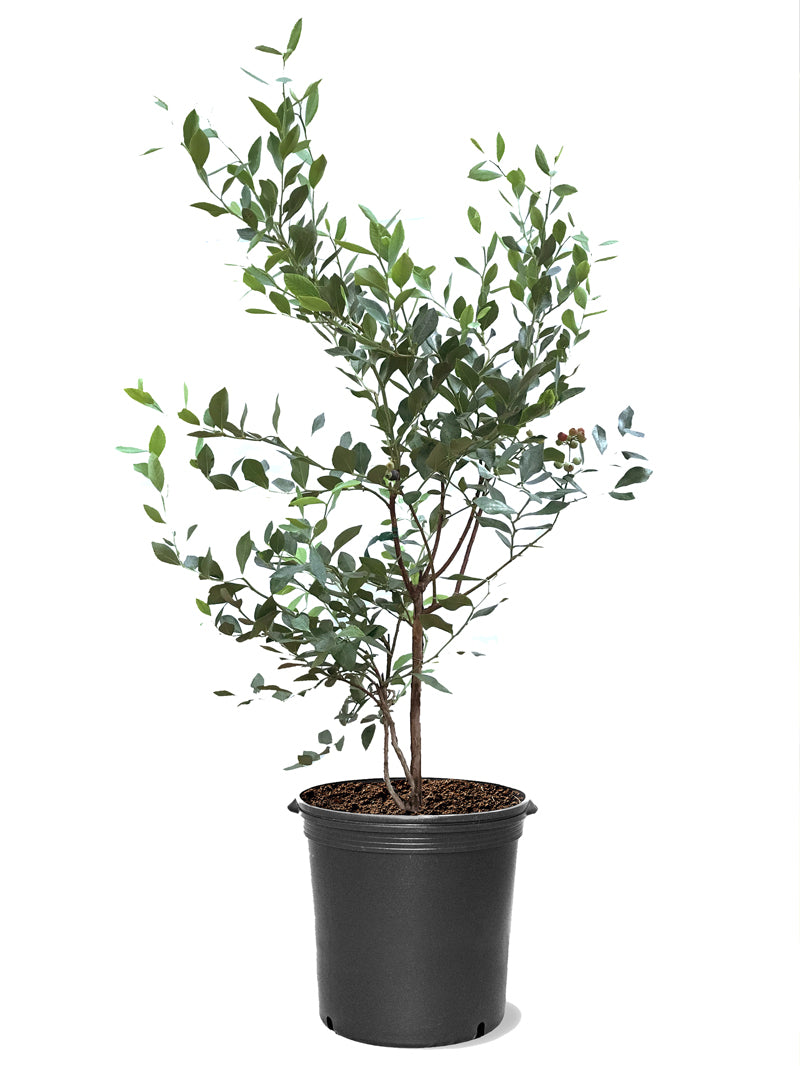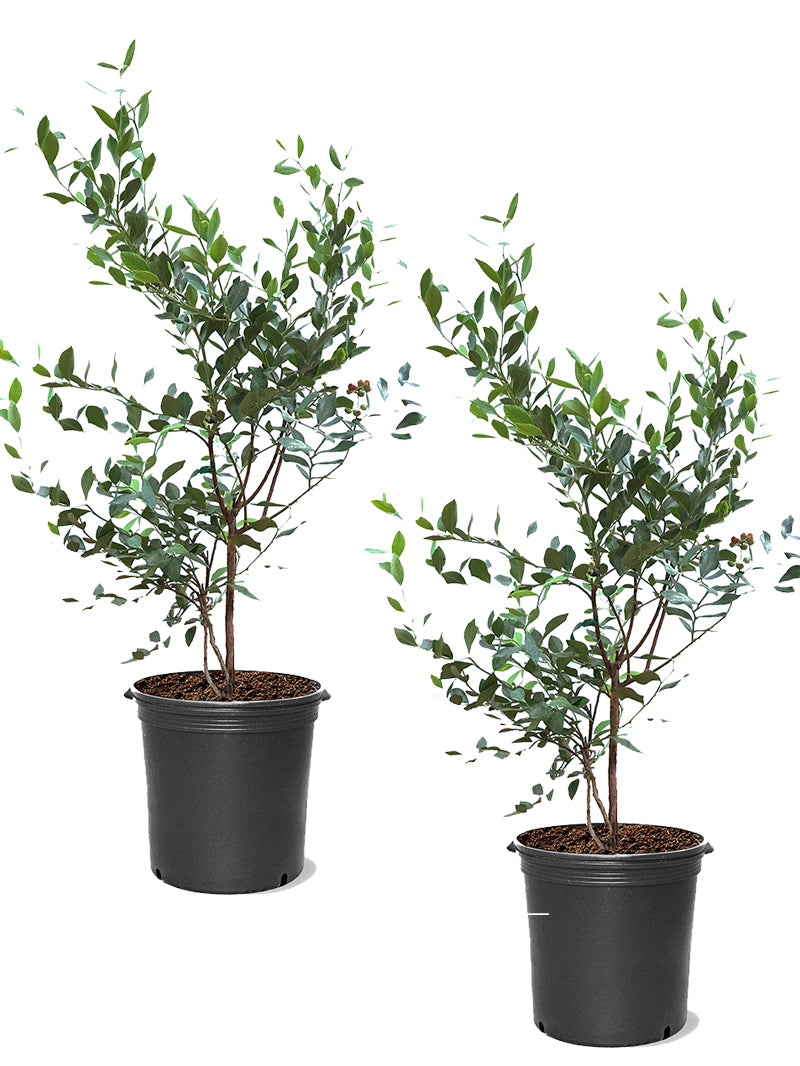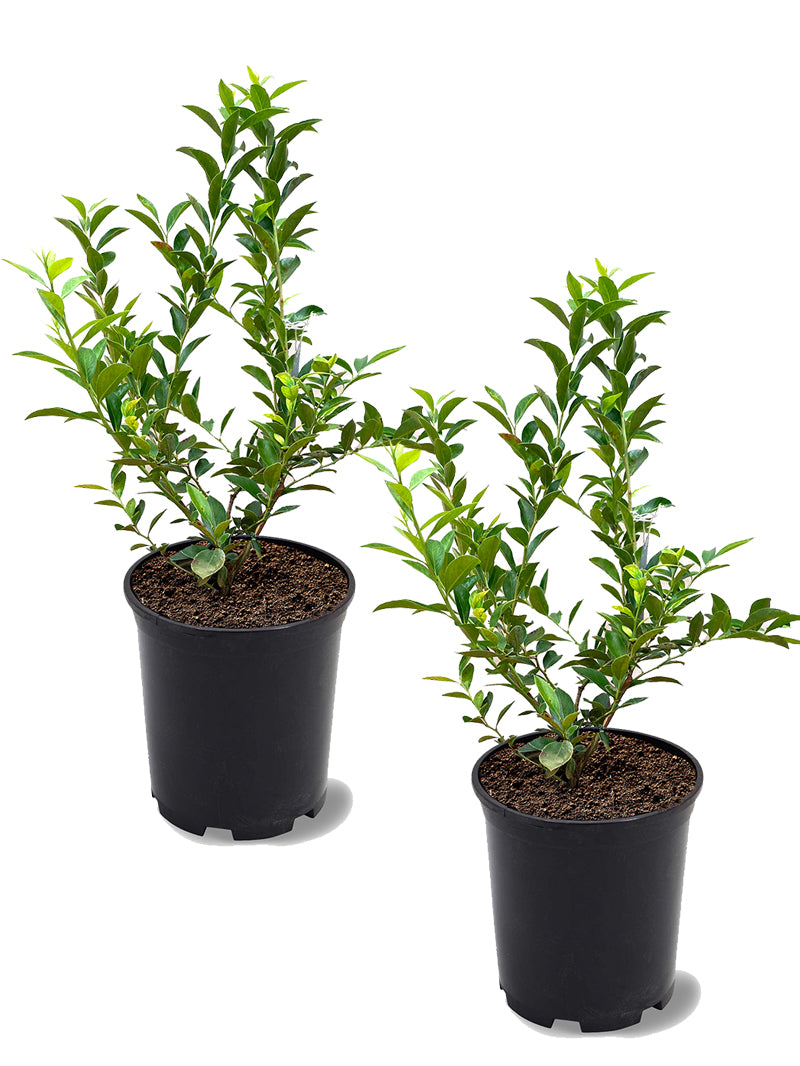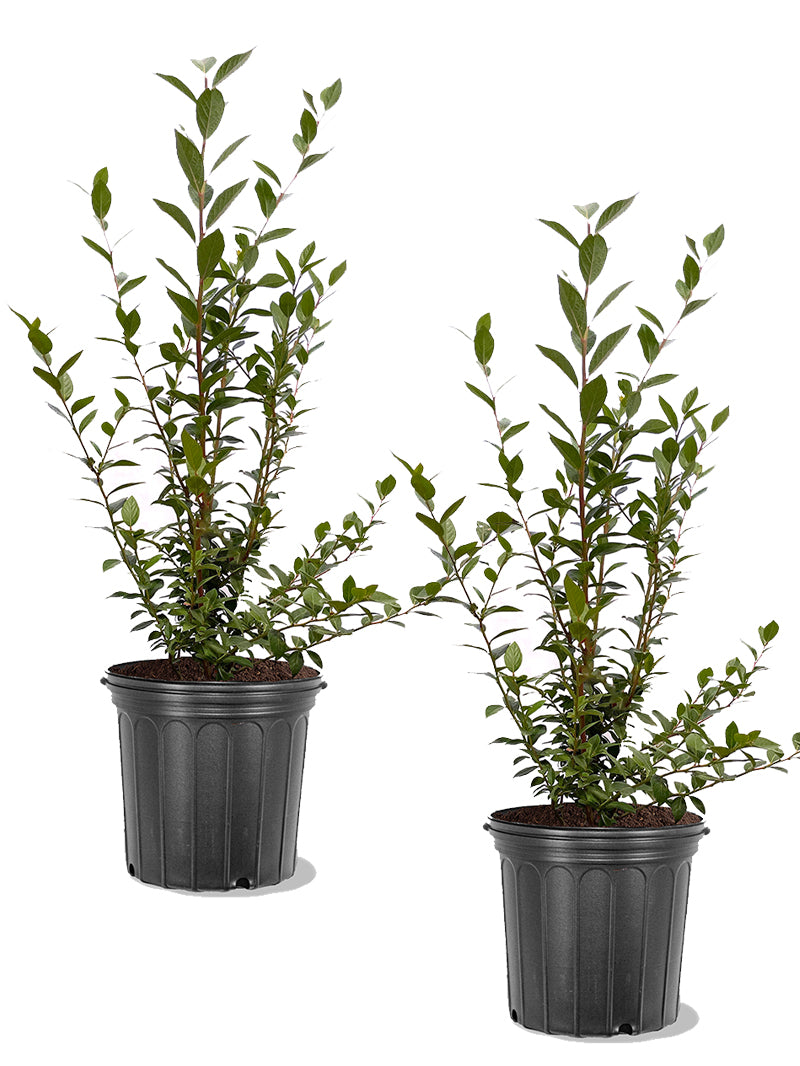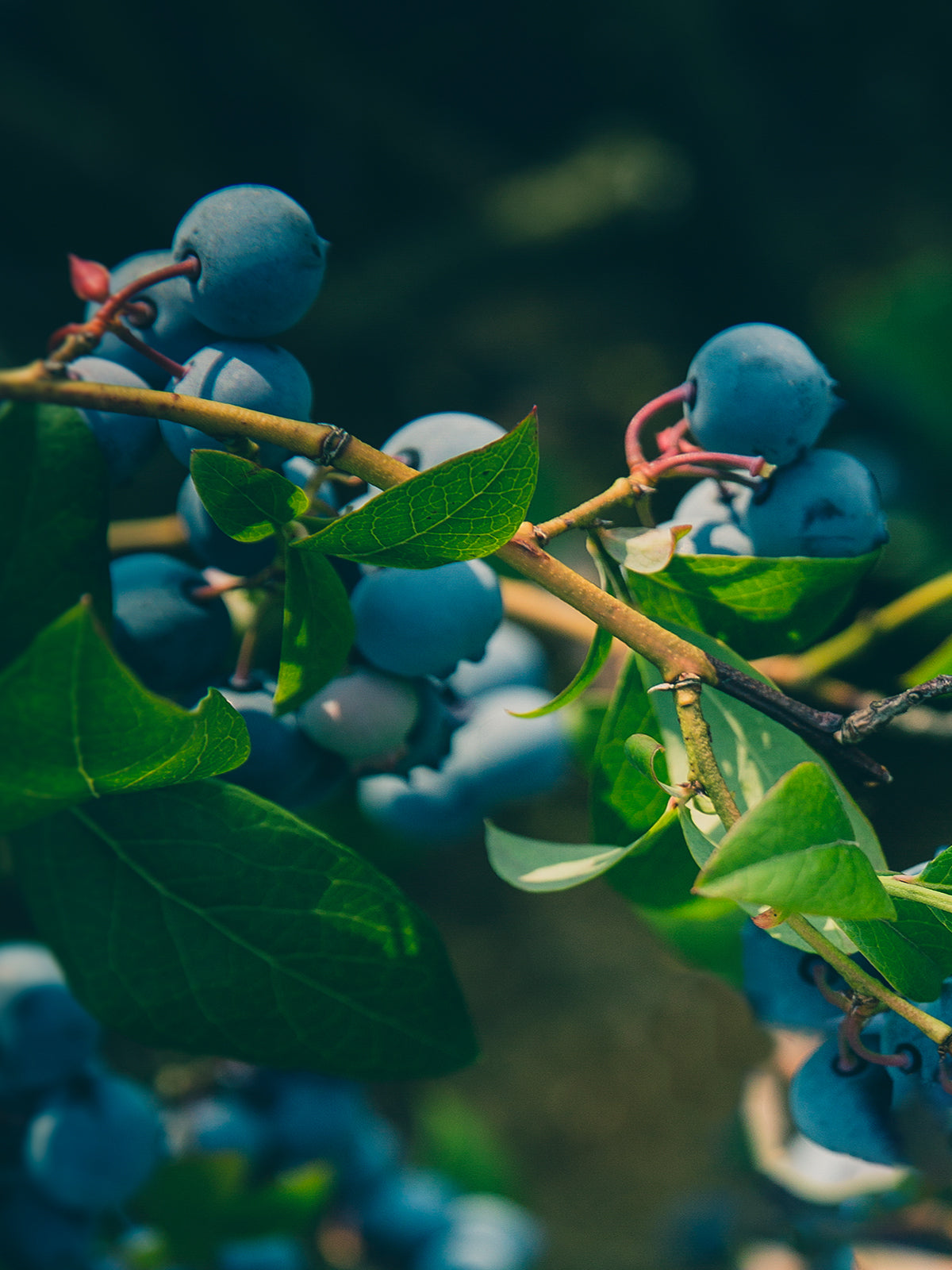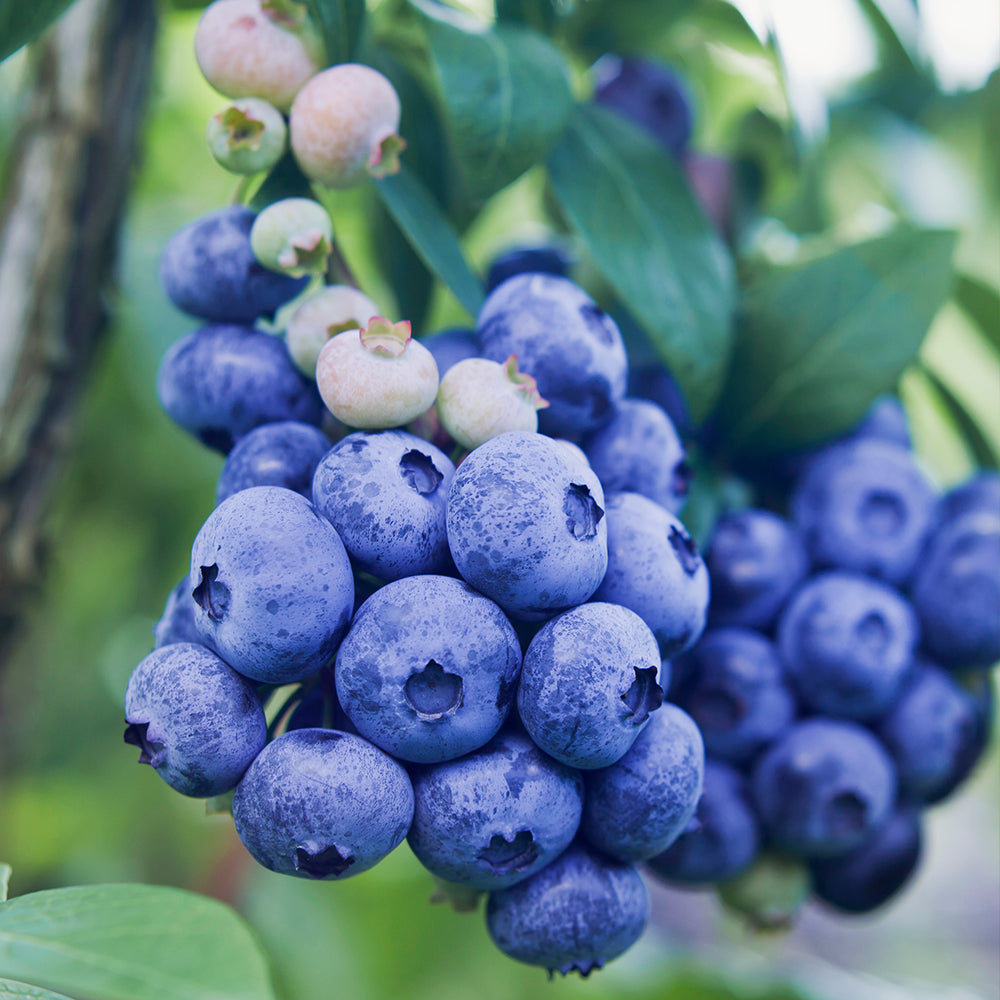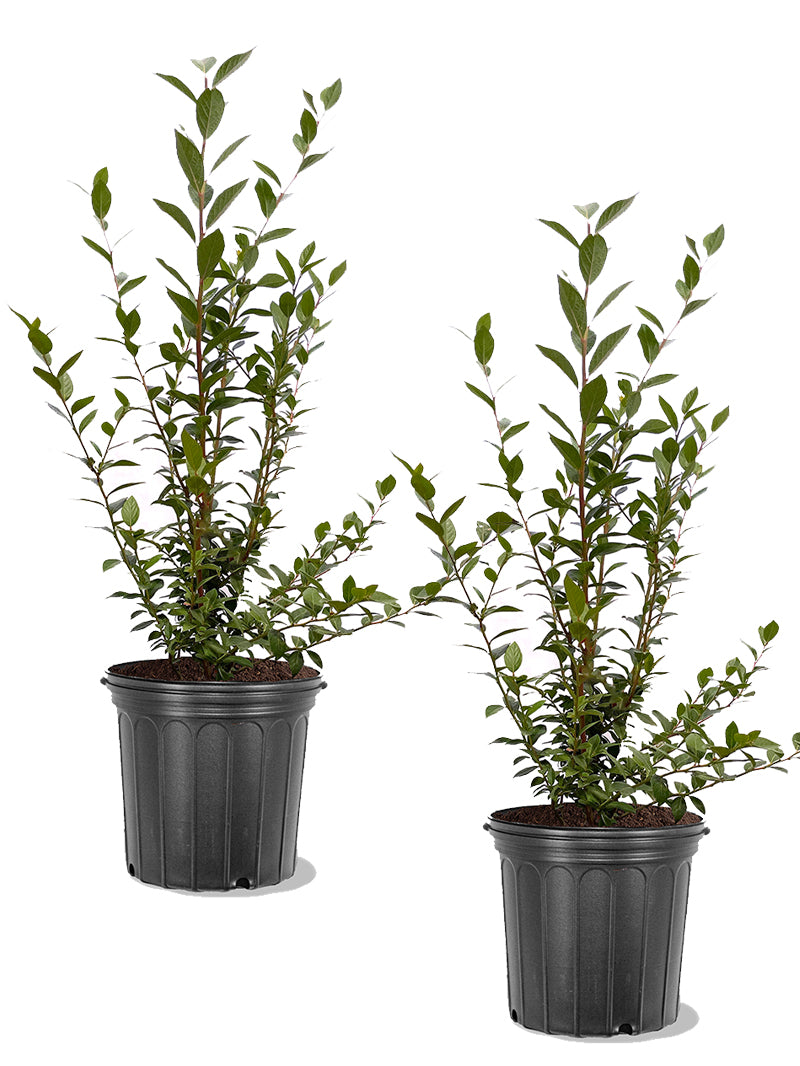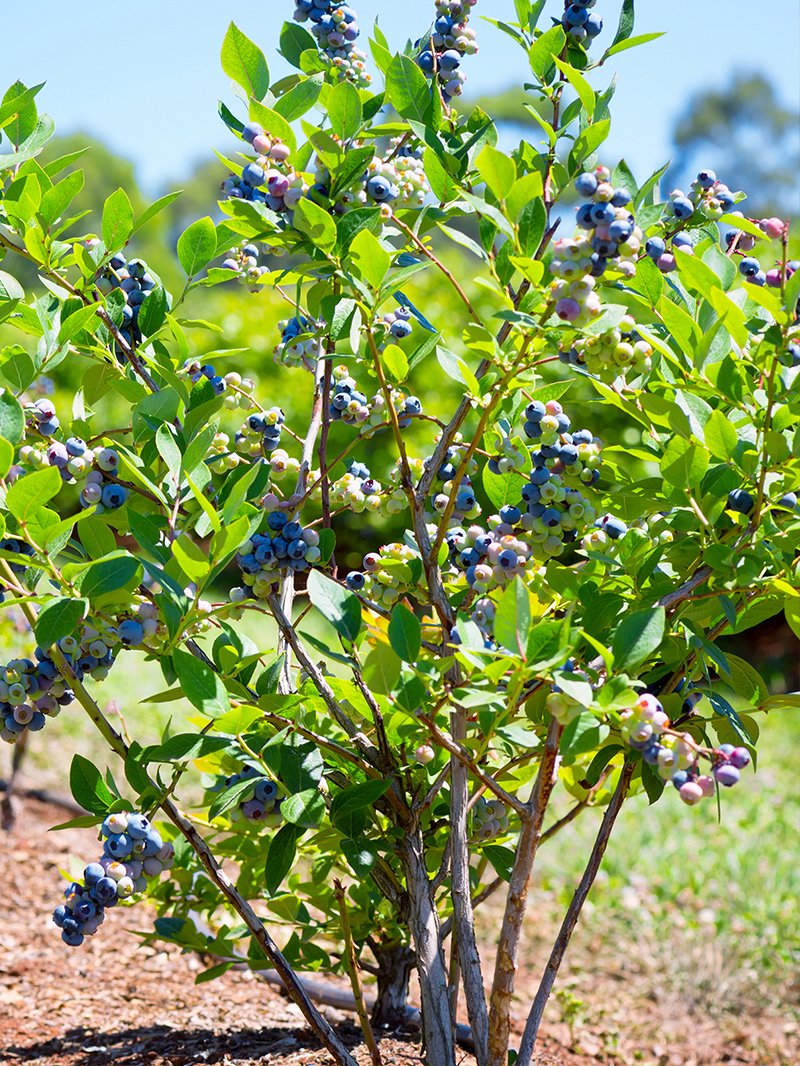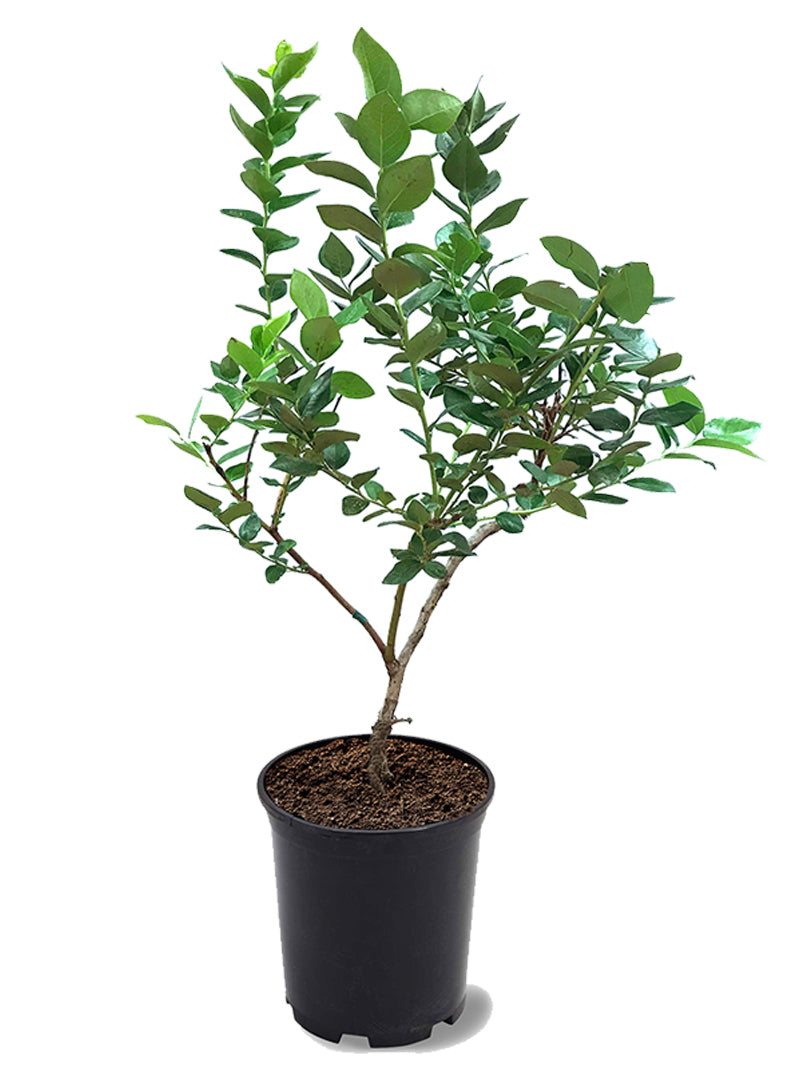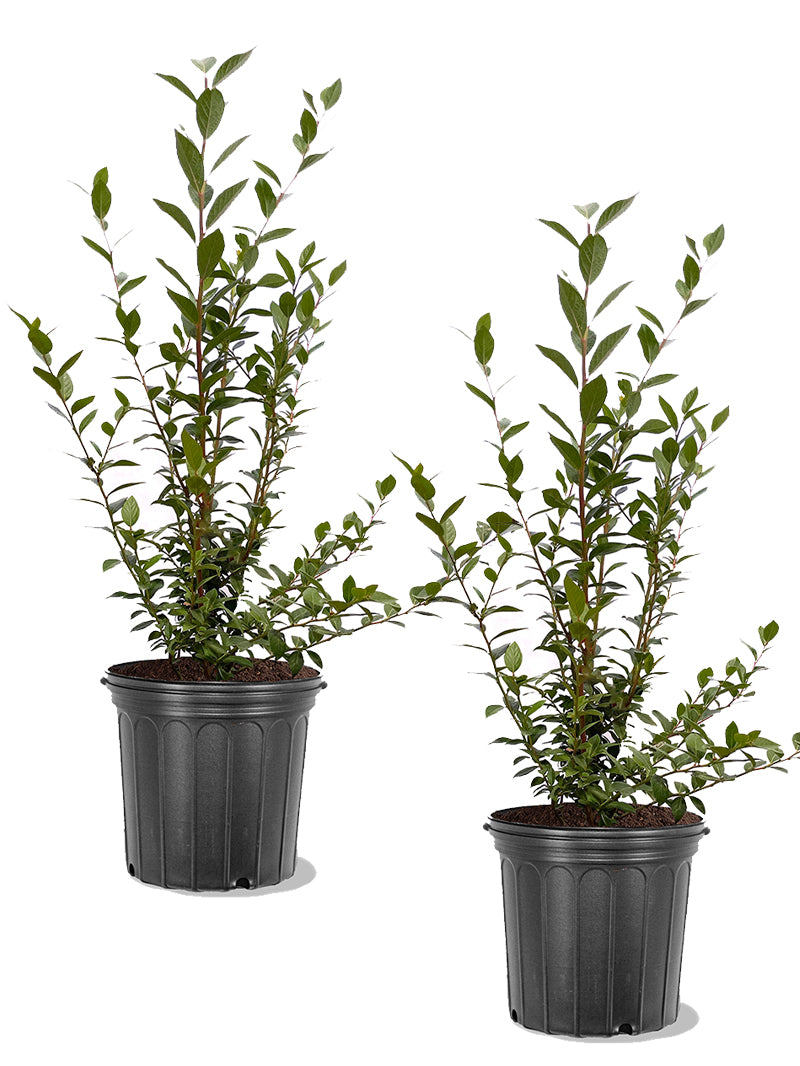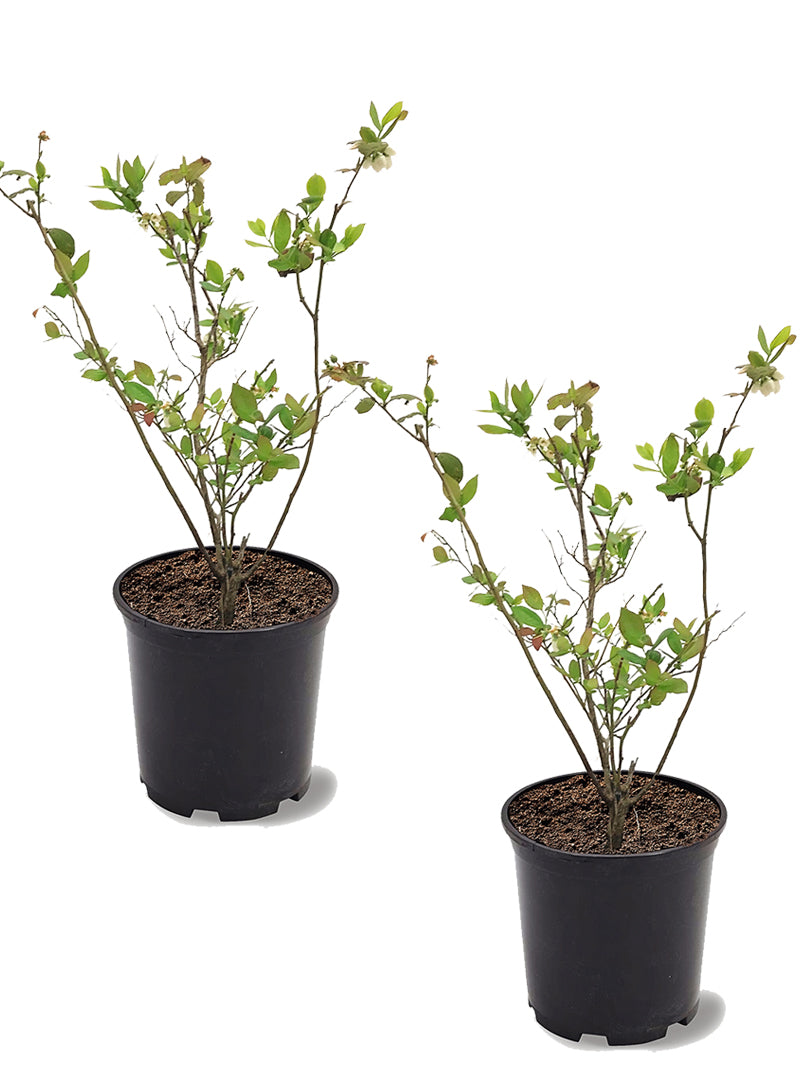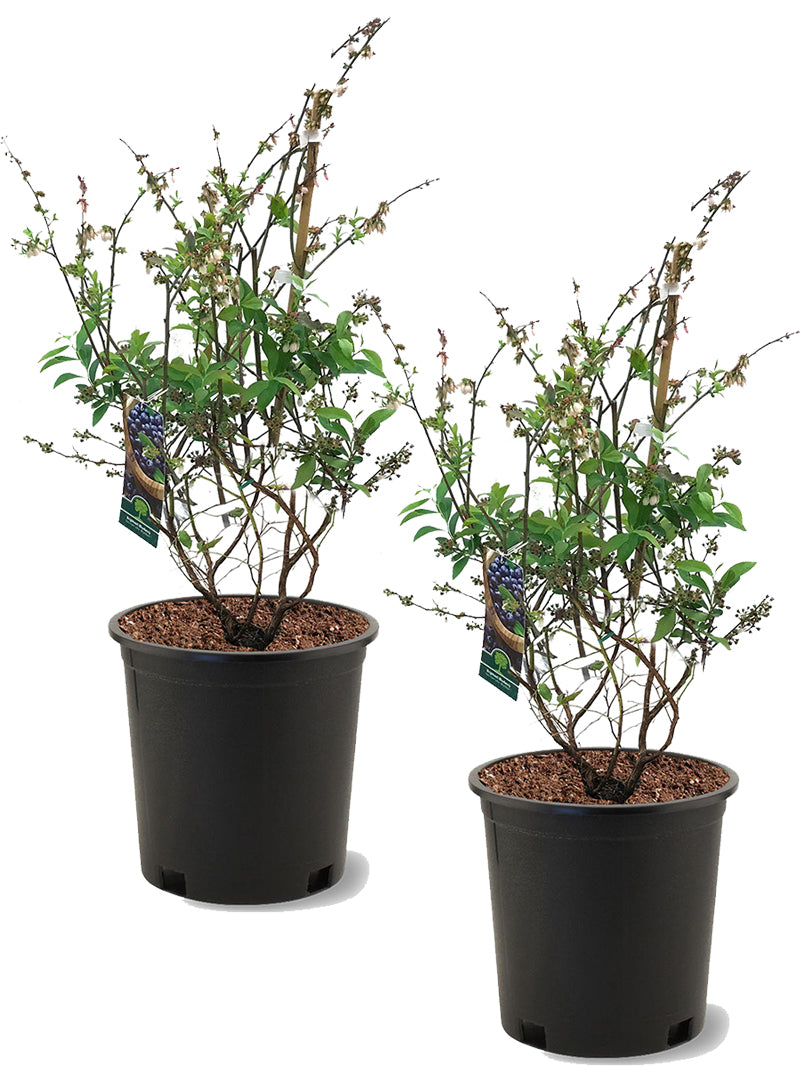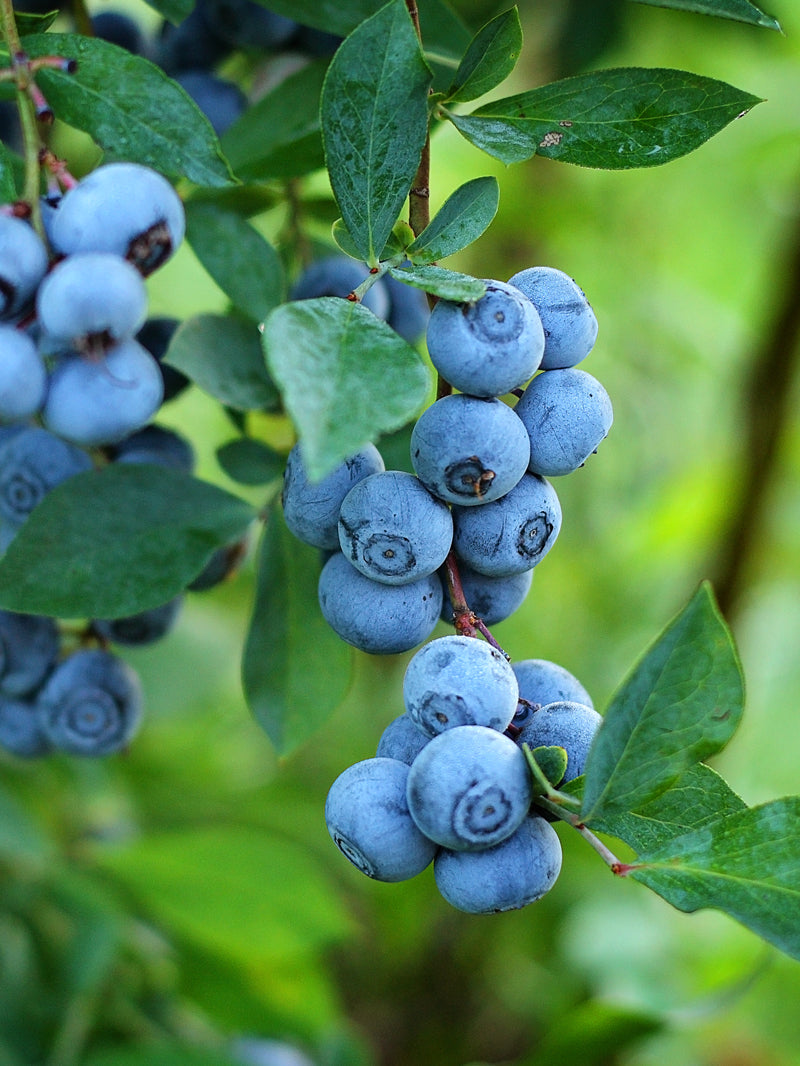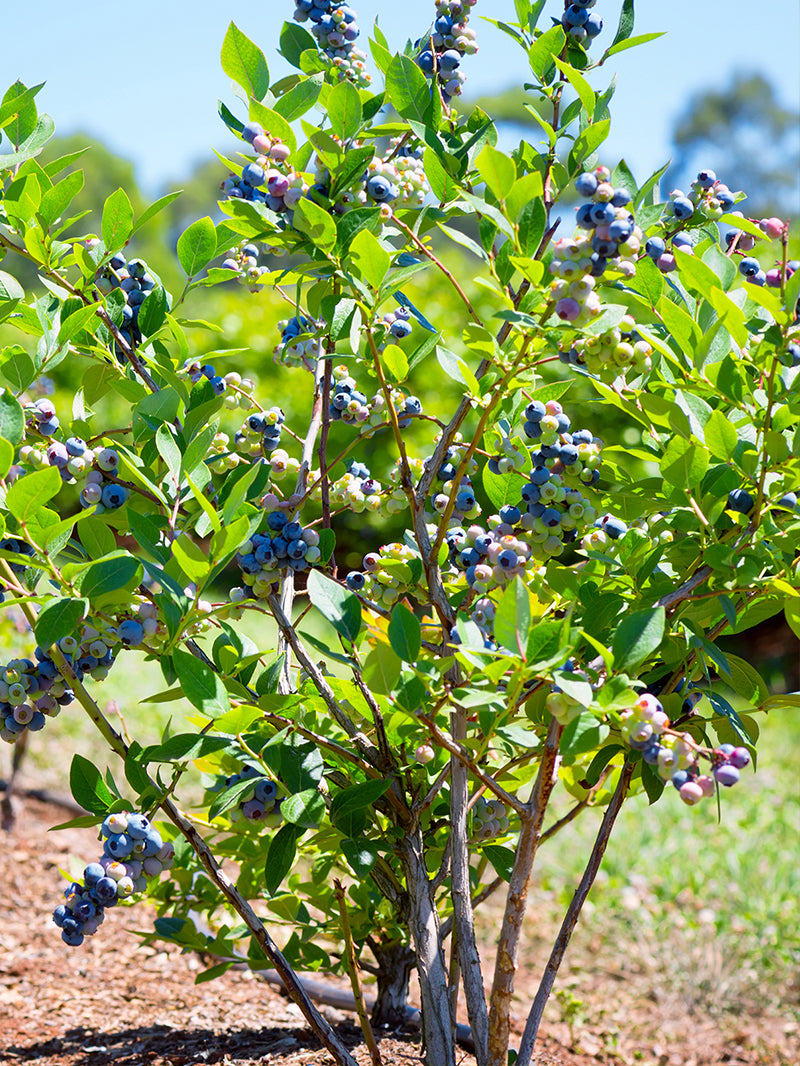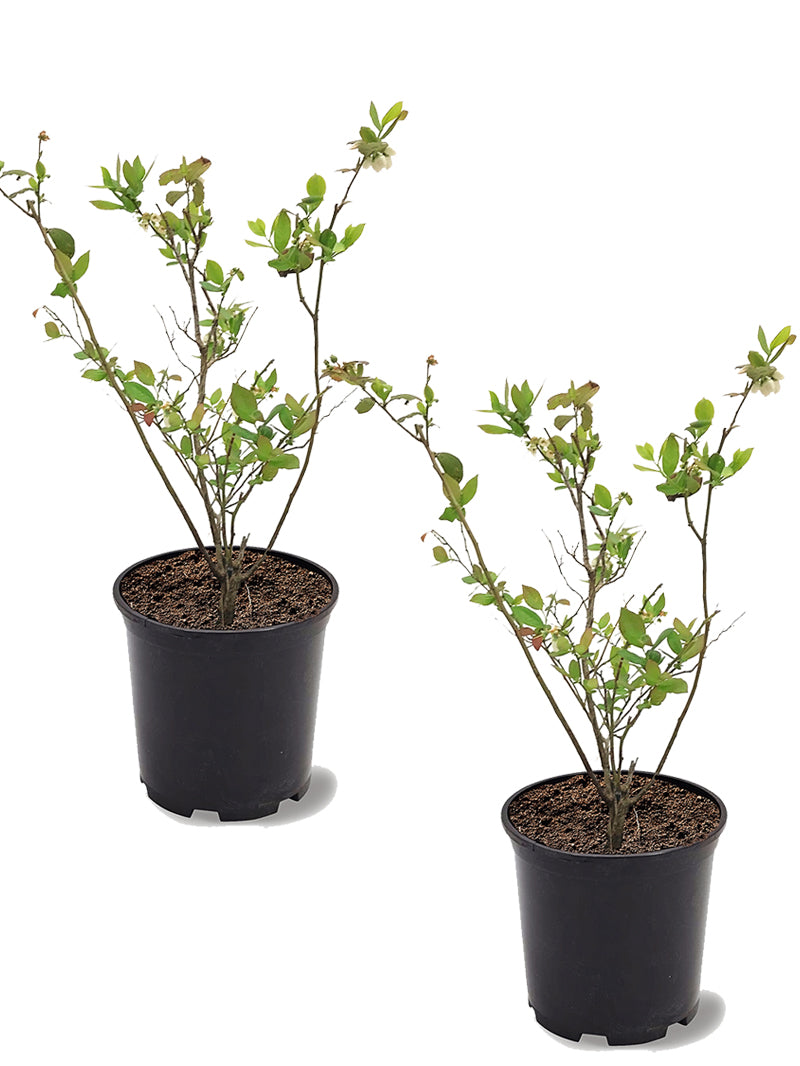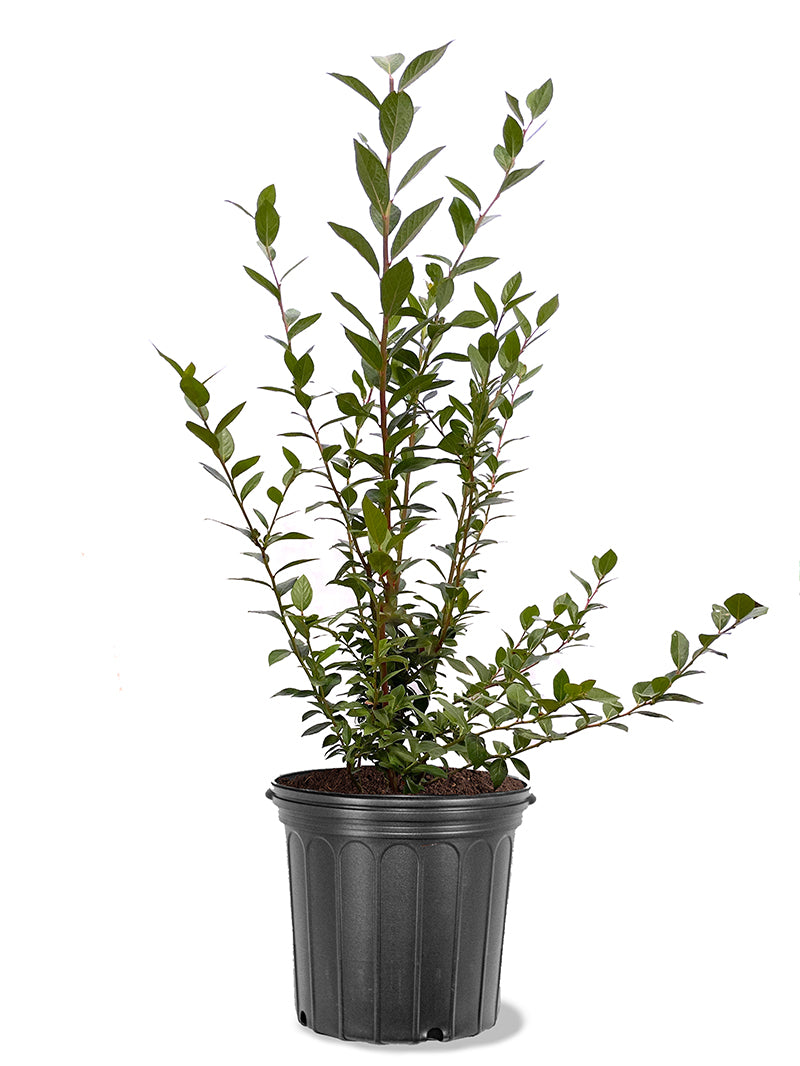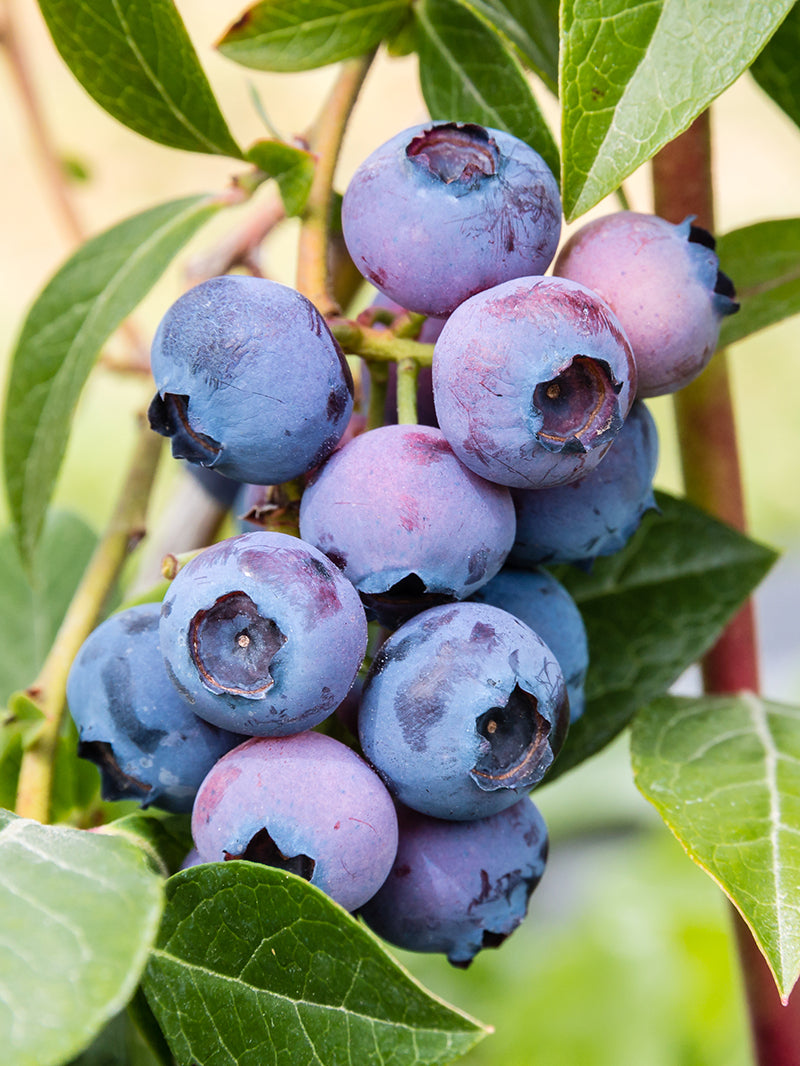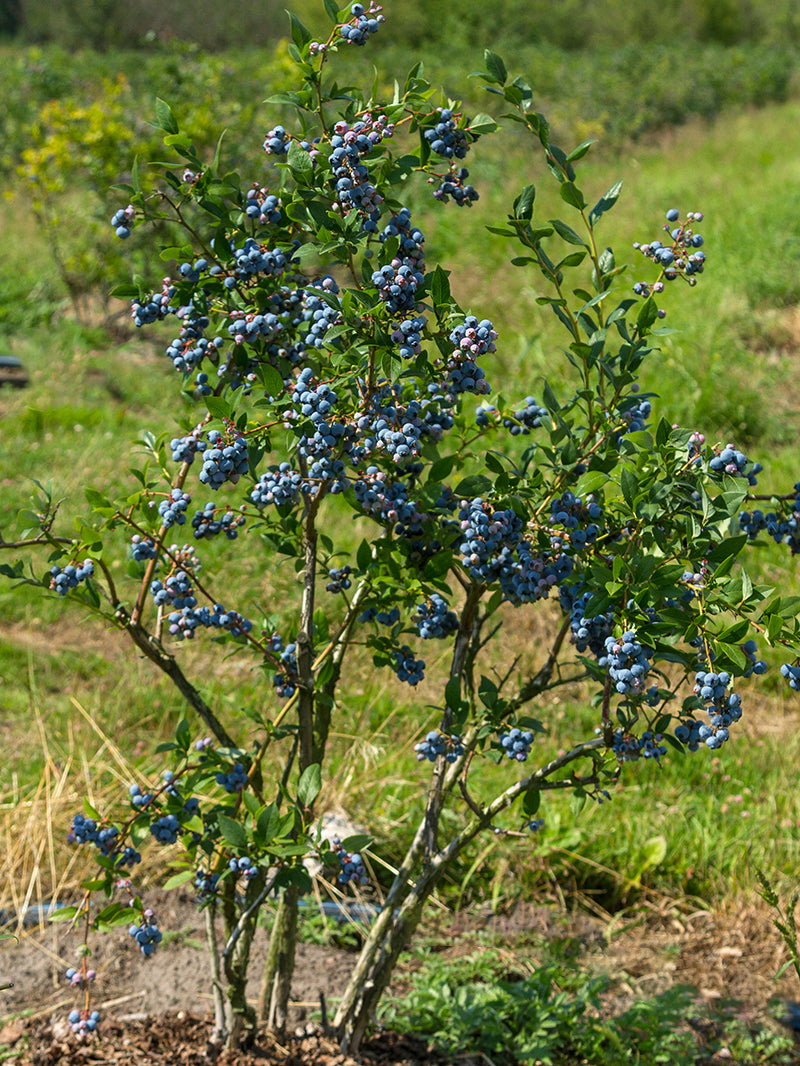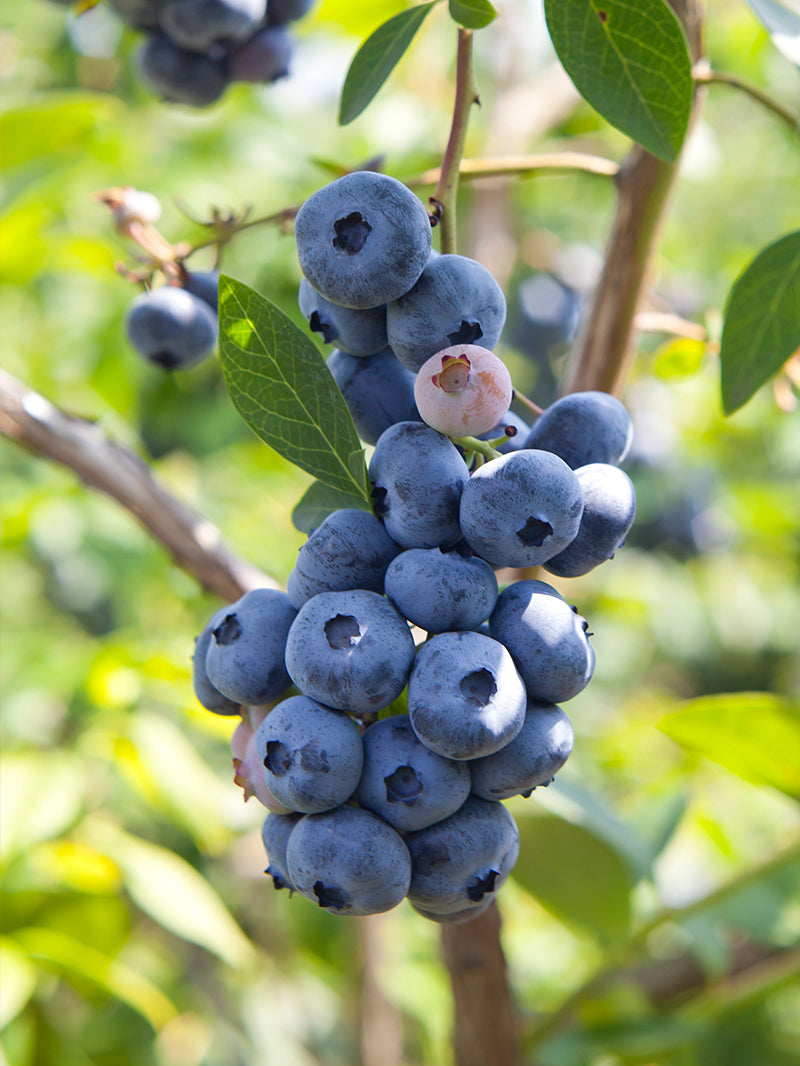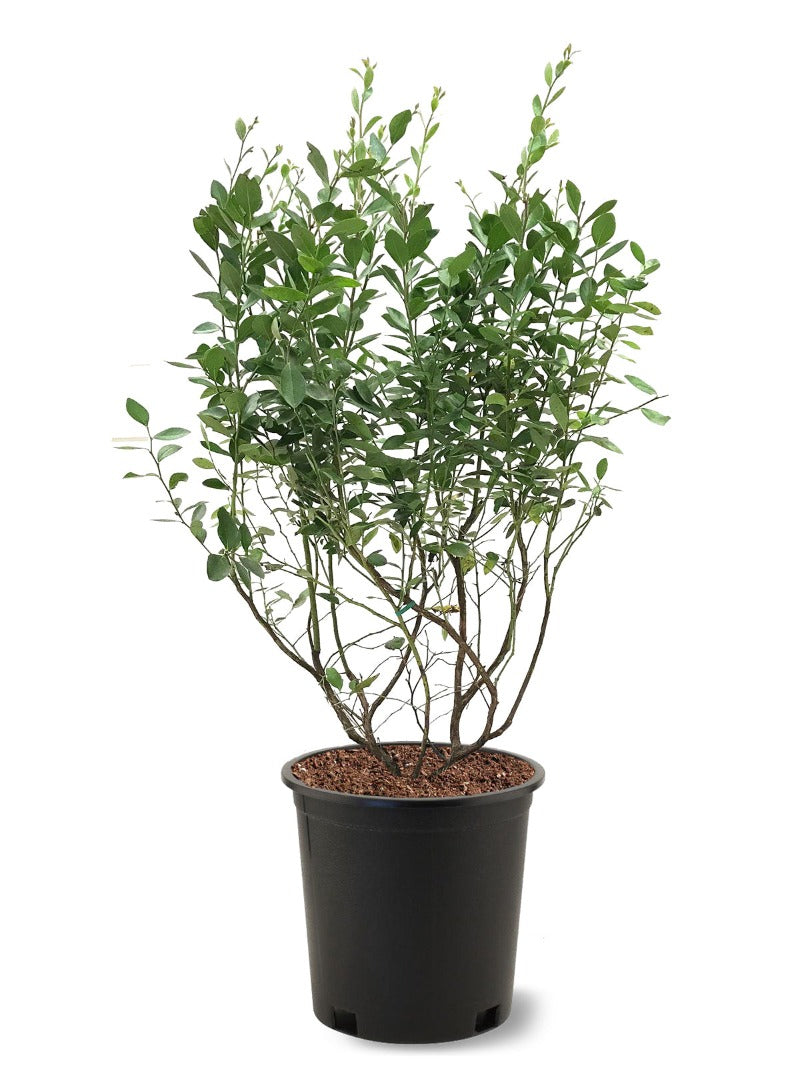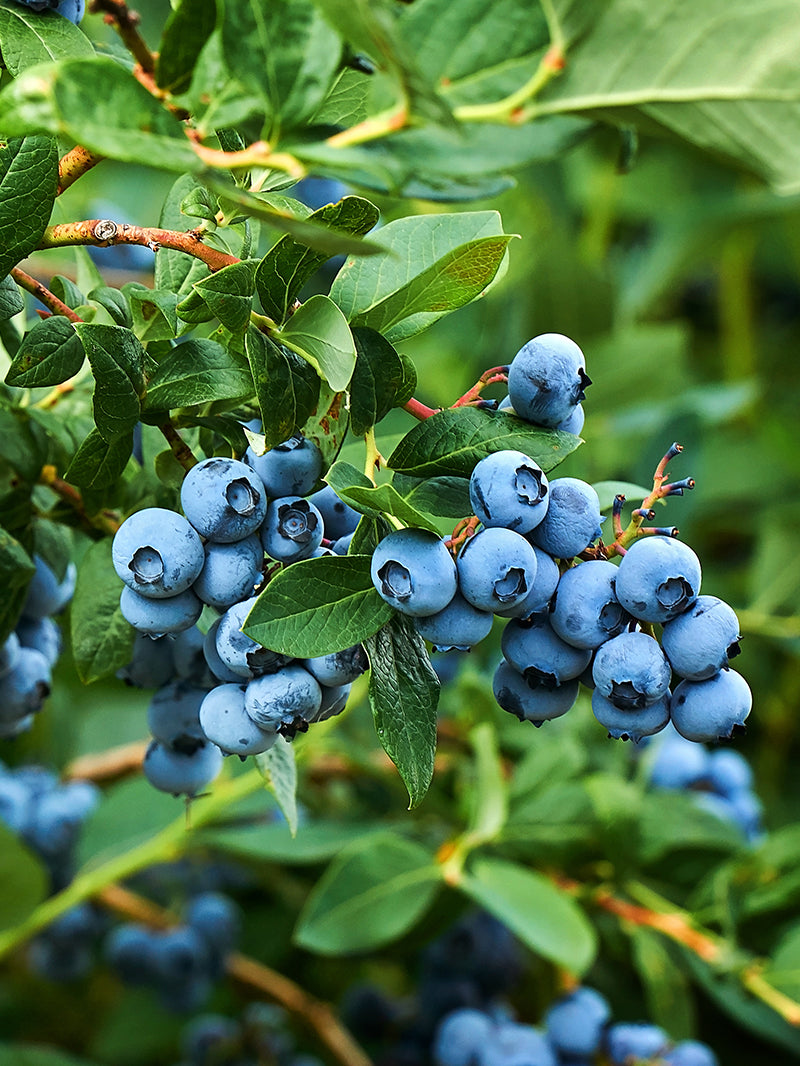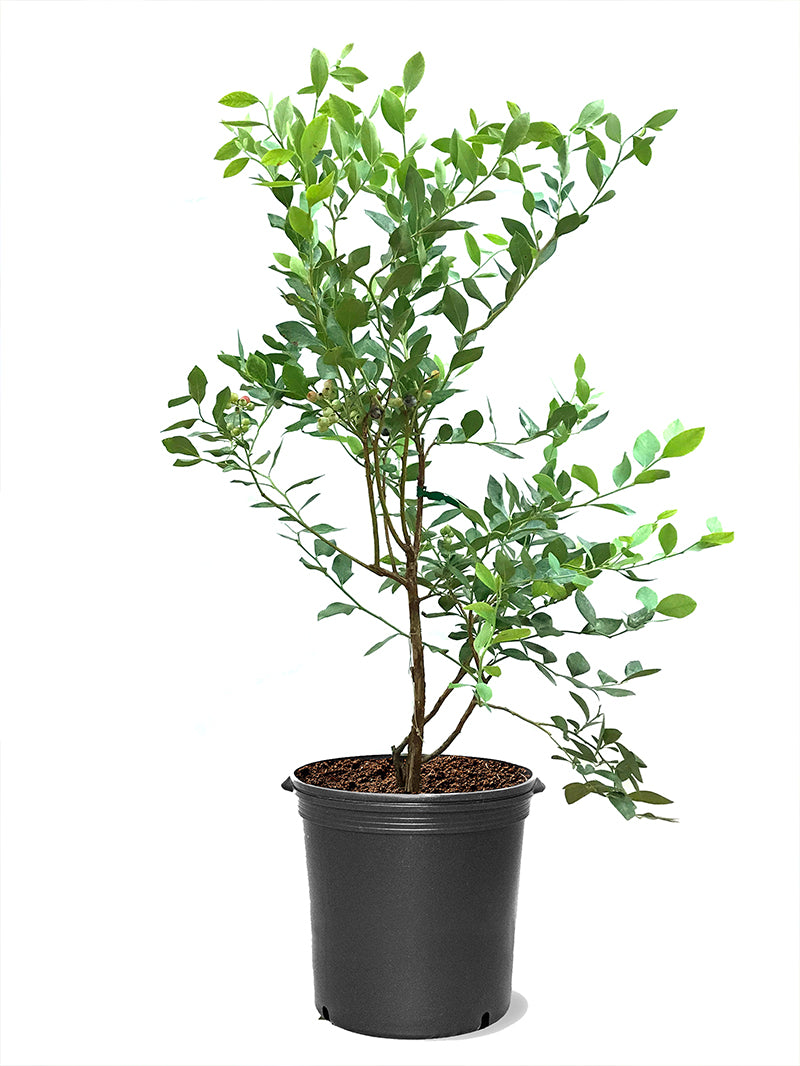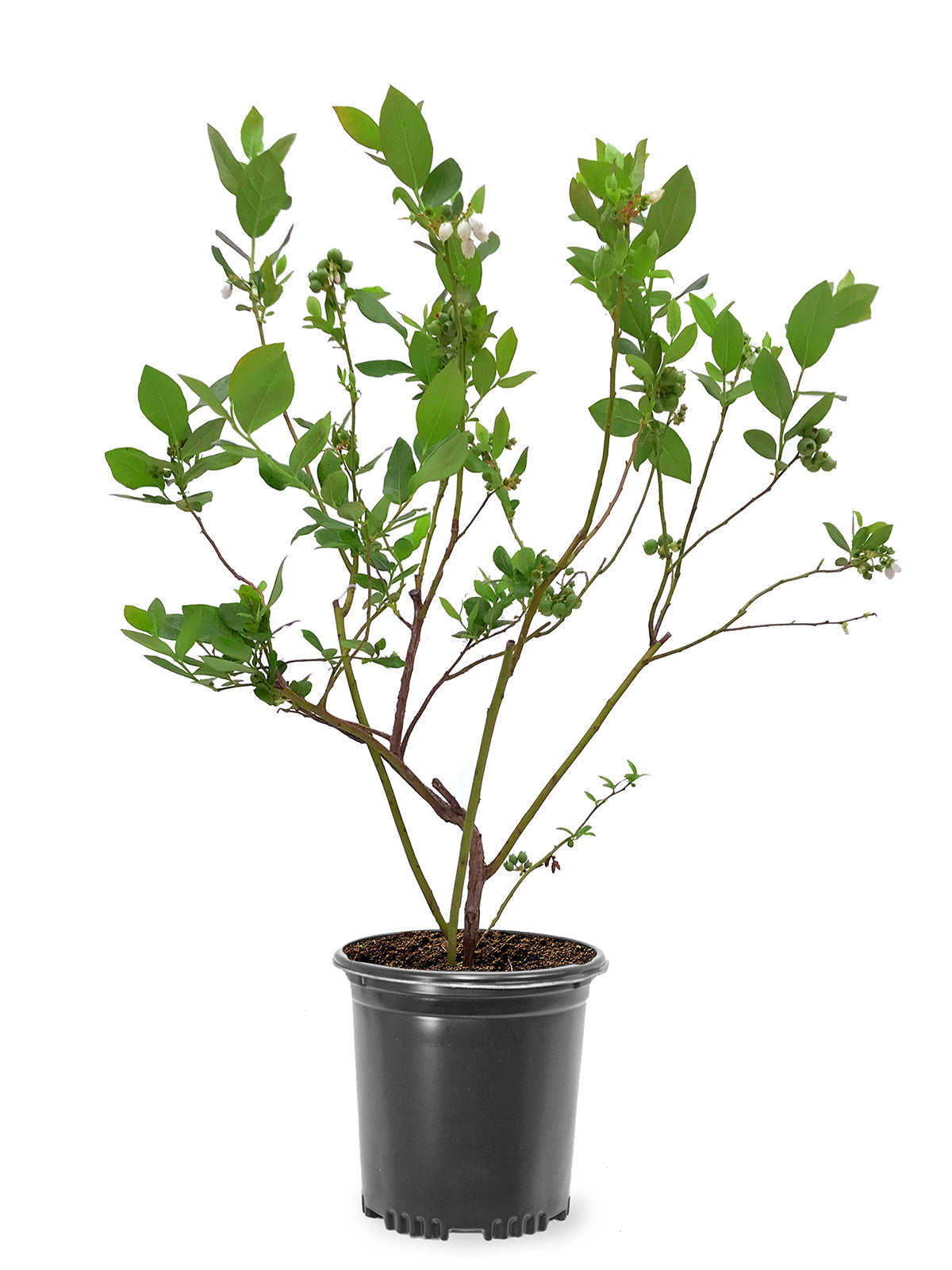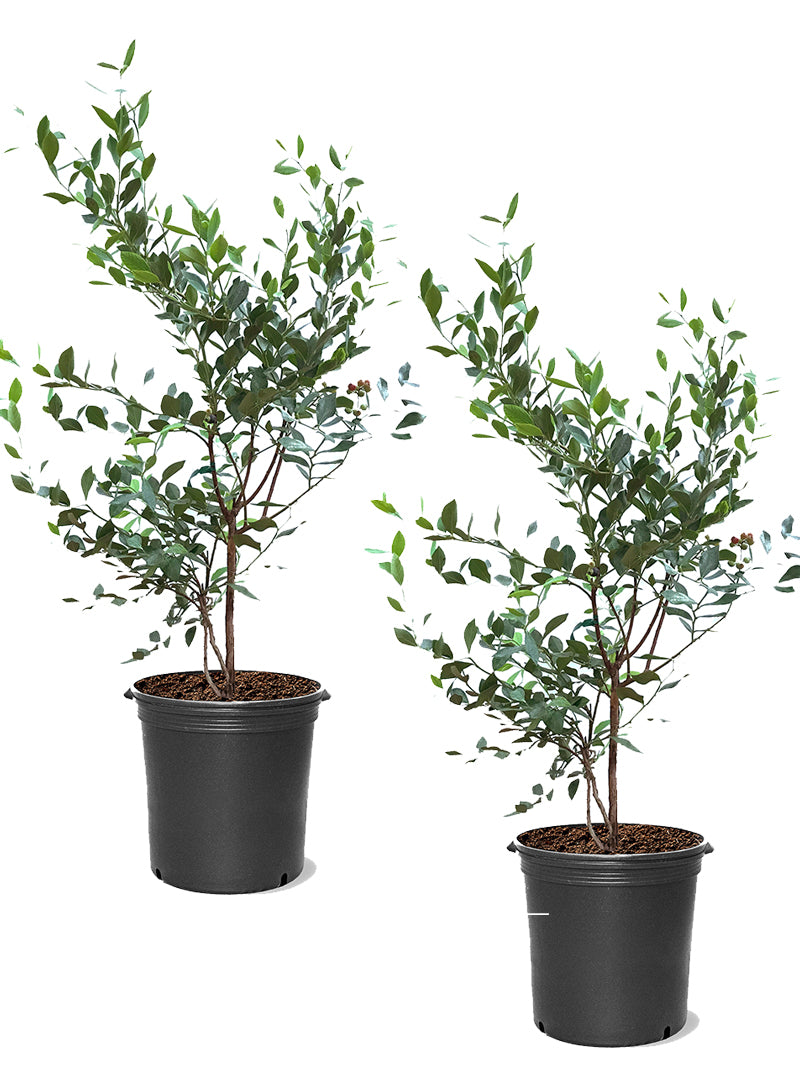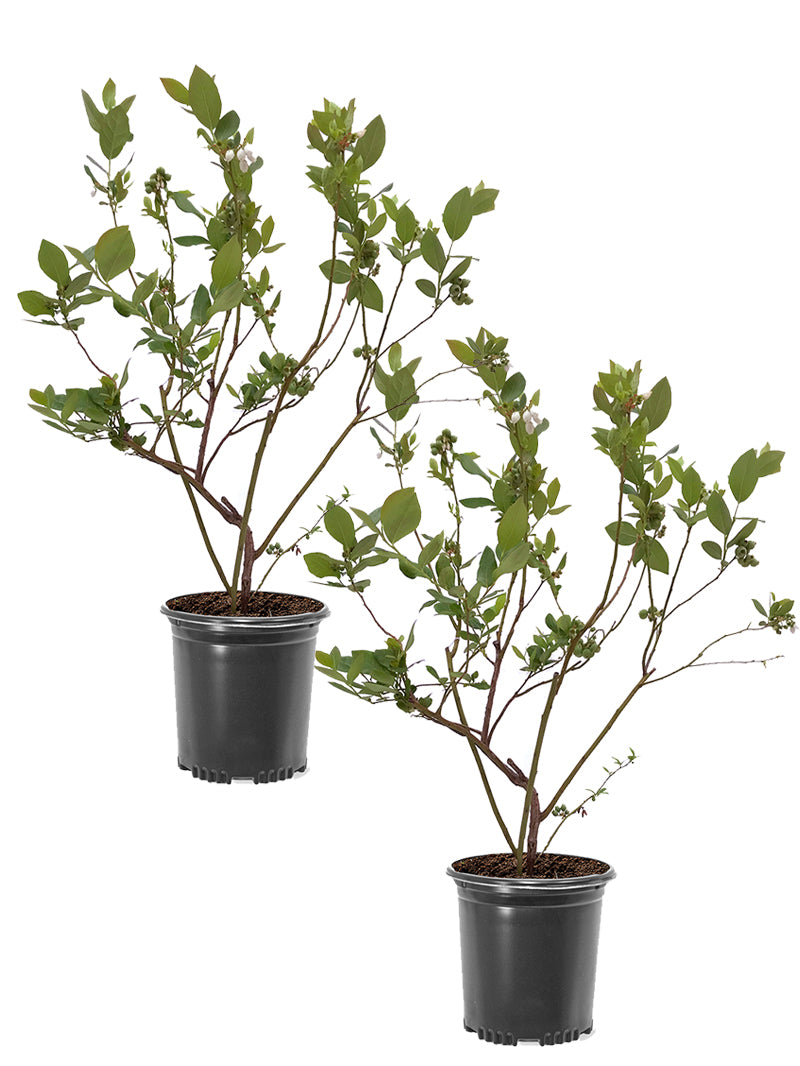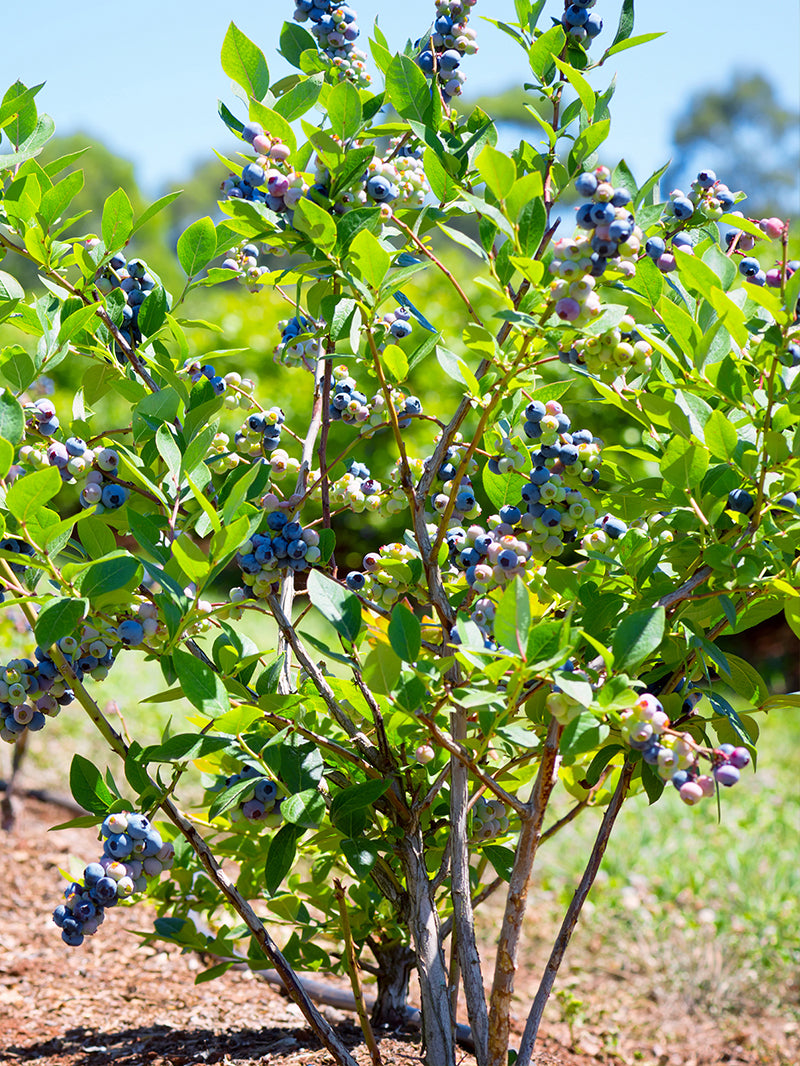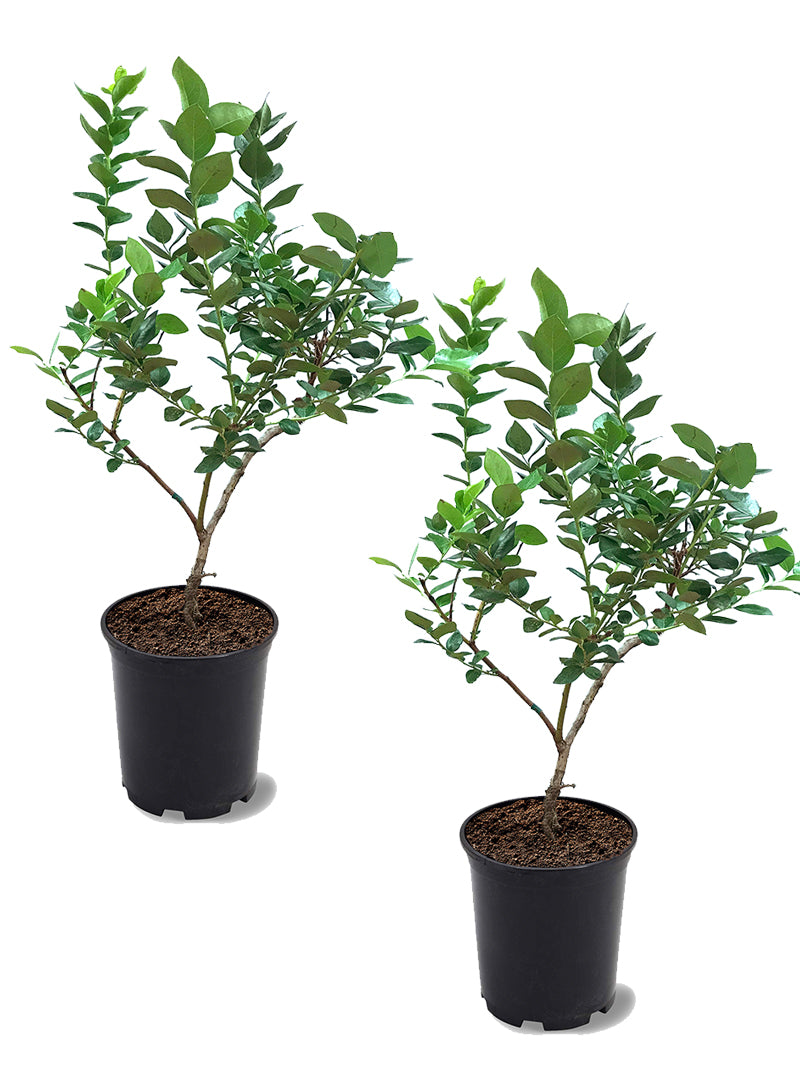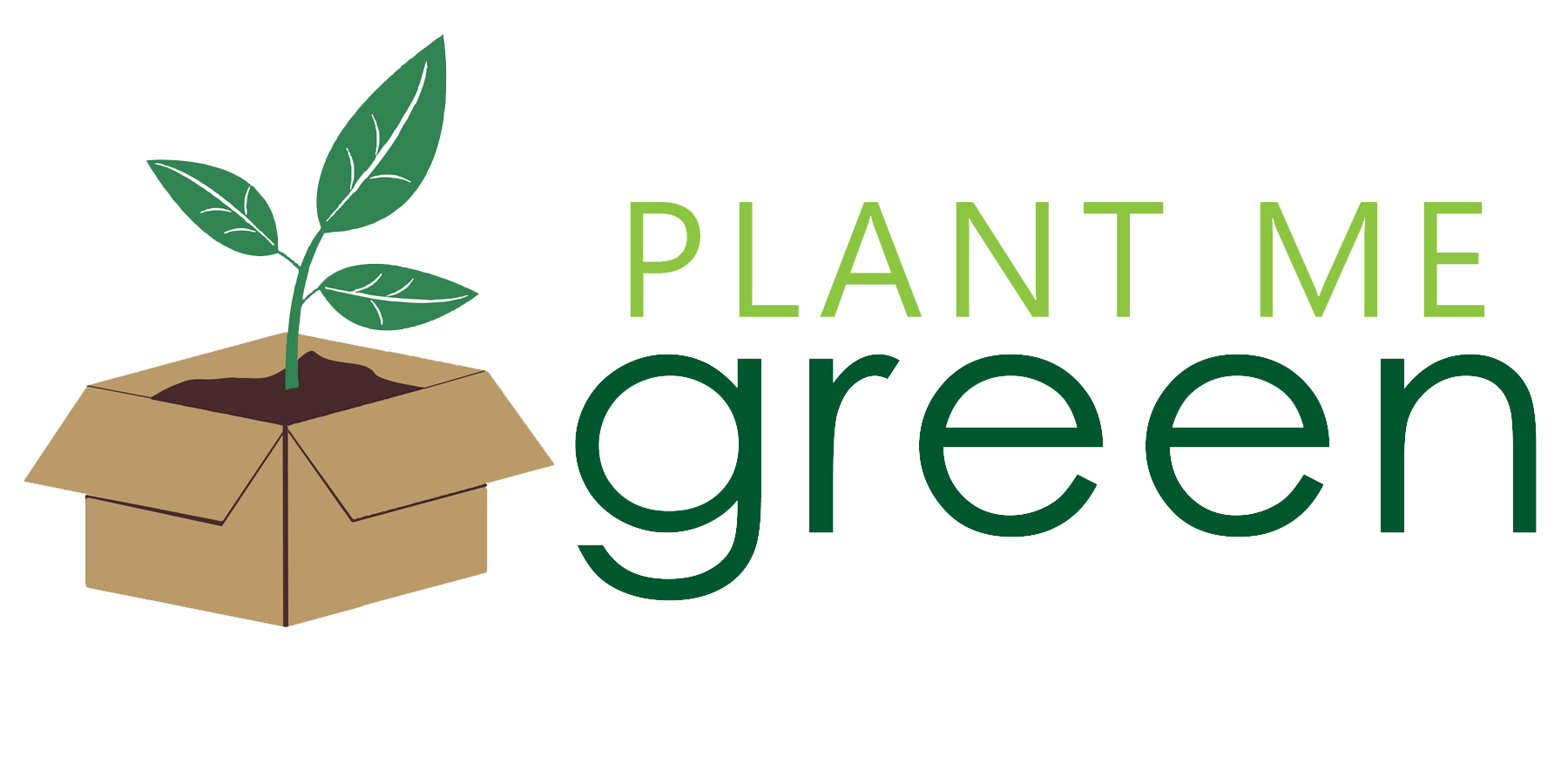
Planning your blueberry bush site
Blueberries are truly an American fruit, with several species native to North America. They are relatively easy to grow when given acidic soils and the right growing climate. Choose varieties that have a chill requirement within 150 hours (above or below) the average chilling for your growing area. Most blueberry varieties need a pollinizer variety planted nearby to produce the maximum amount of fruit. To ensure that each variety is pollinated, choose pollinizers that bloom in the same part of the season as the main variety being grown. For good fruit crops, and vigorous growth, plant in full sunlight.
Soil Prep for Your Blueberry Bush
It’s time to start digging! First, you will need to dig a hole three times the width of the size of the pot, and just as deep as the root ball. The biggest and most important thing to know about blueberries is that they love acidic soil. To be more specific, blueberries grow best with a soil pH of 4.0-5.5. Most average garden soils fall between a pH range of 6.0 to 7.0. Soil preparation should always include a pre-plant soil test. Blueberries are calcifuges—plants that do not tolerate alkaline soil or water and amending with elemental sulfur and iron sulfate to get the required pH is recommended. If amending is not desirable, container growing may be an option to consider.
Blueberries have very shallow roots which do not like competition from other plants. Be diligent about removing any and all weeds, perennial grasses, rocks, tree stumps, tree roots, and anything else in the soil before planting. Prevention goes a long way and is worth the time.
Blueberries like a soil that is high in organic matter. They also tend to prefer a light soil. For these reasons, try adding 40% peat moss and 10% compost, and the remaining native soil should make up the last 50%.
IMPORTANT NOTE! Do not use MUSHROOM compost or composted MANURE in soil used for blueberries. Do not use ALUMINUM SULFATE, as this material is toxic to blueberries. It will likely kill your plants due to the high nitrogen content. If you are unsure as to whether or not your compost is suitable for blueberries, leave it out.
Peat moss is not required but it helps with a heavy clay soil, lower the soil acidity (peat moss on average has a pH of 4.0), and it also helps get the proper soil texture. If you have a loamy soil, close to equal parts sand, silt, and clay, it’s not necessary.
Spacing for blueberries depends upon the desired use in the landscape. Bushes can be planted individually or in a hedgerow. If planting a hedgerow space 5-6 feet apart with rows 10-12 feet apart. If planting bushes individually, place plants for cross pollination no more than 10 feet apart. Remove all flowers the first year to encourage more growth.
Fertilizer for Blueberries
Blueberries are sensitive to excessive fertilizer and to some types of fertilizer. Instead of one high-dosage feeding, apply fertilizer two or three times a year at low rates. Organic and slow-release synthetic fertilizers are preferable for this reason. Avoid fertilizers that contain nitrate forms of nitrogen, which may slow plant growth. Instead, use fertilizers with nitrogen in the form of urea or ammonium. Use urea if the soil pH is sufficiently low (below 5.0), and ammonium sulfate if the pH is slightly high (above 5.0). Ammonium sulfate is more acidifying (reduces pH) than urea.
WHEN TO FERTILIZE BLUEBERRIES:
In USDA Zones 8-9: Fertilize 3x a year— in late February, late May and late July/early August.
In USDA Zones 6-7: Further north, fertilize 1x a year in March or after the buds break. This will probably cause early fruit drop, but growth is more important at this stage on their development.
ALL USDA Zones: NEVER fertilize after August as this will start new growth too late in the year and lead to frost damage.
Be careful to spread the fertilizer evenly over the blueberry’s root zone and water it in well. Blueberries form suckers and the plant expands each year, the amount of fertilizer applied increases each year until the 6th year after planting.
If your young blueberries aren’t growing, they may be stalled. If this is the case, try to supplement your fertilizer with a liquid fertilizer (like Miracid). Spray them once a week for a month, if they still haven’t grown 6 inches continue treatment. If a blueberry does not doubt in size its first year, it will be stunned.
|
21-0-0 (ammonium sulfate) |
Year 1: No fertilizer Year 2: 2.0 ounces of 21-0-0 (ammonium sulfate) per plant during bloom, and the same amount 3 weeks later. Scatter in a ring 12 in. to 18 in. from the plant Year 3+: Increase by 1.0 ounce per year until the 6th year; then use 8.0 ounces per plant each succeeding year |
|
Espoma Citrus Tone (Organic) |
Year 1: 1 ½ cup per plant in late Feb., late May and late July Year 2: 2 ½ cup per plant in late Feb., late May and late July Year 3: 4 cups per plant in late Feb, late May and late July Year 4+: 6-10 cups for every 4ft of row. Spread fertilizer in a 4ft wide band down the row in late Feb. late May and late July |
Water For Blueberries
The first year is a critical time for your new blueberry. It has not had time to establish itself yet and therefore is not as strong as an older tree. To prevent the tree from dying, it must be watered twice a week on light soil and once a week on clay soil. Be sure to soak the entire root system deeply. Yellowing and dropping of leaves may indicate drought or over-watering.
For best growth and production, blueberries should receive at least 1 inch of water a week. You must supplement rainfall when necessary. Since blueberries are so shallow rooted, we recommend that irrigation be installed when you first plant your blueberries. Blueberries should be watered especially during dry spells, water is mandatory. If not properly watered during dry spells, fruit may drop prematurely. Keep at least 4 feet around the blueberry clear of grass and weeds, for less competition for water.
Pine bark mulch, rotted sawdust, and compost are good mulches. Apply them to a depth of 2 - 3 inches and replenish them whenever necessary. Avoid mulch with a high pH, such as mushroom compost.
Pruning blueberries
Training Young Plants (1 to 3 years of age)
If vigorous, well-rooted two-year-old plants are set, they do not need cutting back the first year except to remove fruit buds shortly after planting. Pruning should be moderately heavy in the second year to stimulate strong new growth on selected canes. Do not permit plants younger than three years of age to bear more than a cluster or two of fruit, or the onset of the commercially productive period will be delayed. A large bearing area should be established in the shortest possible time.
Pruning Bearing Plants (over 3-4 years of age)
Make large “shaping cuts” — remove all low-spreading branches and the oldest canes if they are weak, particularly if in the center of the plant. “Head back” the upright “bull shoots” to the desired height to keep the bush from growing too tall. Essentially, you have then automatically selected the remaining, more upright canes to bear your crop next season and the following season.
On the remaining canes, systematically “thin out” the shorter, thinner shoots, leaving enough of the thick shoots to bear the crop and make new growth. Only experience can tell you how many shoots a particular variety of a particular age can carry and still perform well. It is probably better in most instances to prune too lightly than too heavily. Lighter pruning is usually practiced, as the plant grows older because it can carry more “wood” successfully due to a larger root system.
Renewal Pruning
When blueberries are about 8 to 10 years old, they are at their productive peak— but renewal growth has reached a minimum, and production will begin to decline from year to year. To prolong your plant’s productivity, renewal pruning is needed. Some provision must be made to revitalize the plant to prolong its productive period.
How To Container Grow Blueberries
Growing blueberries in containers is so easy and effective that you might want to try it even if you have enough in-ground garden space where you can plant this antioxidant-rich fruit. If you want to grow blueberries but your soil isn't optimal for producing the fruit, this is an excellent solution. Blueberry plants can thrive and bear fruit in containers in any area that receives full sun. Just be aware that growing blueberry plants in pots (or anywhere else) requires some patience. As with most fruit-bearing species, it can take a few years for plants to produce fruit.
Step 1: Choose the right size container—Blueberry bushes thrive when grown in containers, because their shallow root system easily adapts to the small space. Choose a container that's at least 18 inches deep and boasts ample drainage holes and keep for the first two to three years. When the bush outgrows the smaller pot, transfer it to a 24-inch-diameter container—about the size of a barrel planter. With big pots, putting the containers on rolling casters makes it easier to follow the sun. To get started with the right soil mix, fill your pots two-thirds of the way full of regular potting mix, adding a potting mix designed for acid-loving plants (such as rhododendrons, azaleas, and camellias). Make sure to test the soil's pH regularly.
Step 2: Proper Care and Tips—Blueberry plants have shallow roots that dry out fast so they need a lot of water, but they also like sandy, well-draining soil. In other words, they don't like to be sitting in water, so keep the soil consistently moist, but not soggy. Though some blueberry bushes are self-pollinating, many others rely heavily on bees to help with the process. You can get away with growing just one plant, but to get larger berries and bigger yields per plant, grow at least two selections for better pollination. Blueberry bushes can grow large, but they won't need pruning until their fourth year in the pot. The pruning will stimulate more growth. Prune the bushes before it begins its new growth phase.
Step 3: Protect During the Winter Months—Containers of blueberries need to be placed in a sheltered spot between December and March when winter winds are at their worst. Blueberries do not like overly dry conditions, and that includes dry winds in addition to cold winds. In coldest regions, move pots into an unheated garage or sheltered spot; cover soil with a deep layer of mulch or swath entire plant in burlap or a blanket. Bring outside in spring when the threat of frost has passed.
Blog: Blueberry Care Articles
THINGS TO KNOW ABOUT PLANTING BLUEBERRY BUSHES IN YOUR YARD
Are you looking for a fantastic, delicious, and easy addition to your property? Look no further; blueberry bushes are the perfect option for you.
USEFUL TIPS FOR PRUNING YOUR BLUEBERRY BUSHES
Blueberry bushes are a joy to grow in your backyard. To get the most out of your plants, follow these useful tips for pruning your blueberry bushes.
Shop our collection of blueberries and have them shipped right to your door!
